Planning a trip around the Iceland Ring Road?
We’ve got you covered with this extensive itinerary that will take you to the best stops across this beautiful land of fire and ice.
Iceland’s spectacular landscape changes wildly from place to place.
One minute you’re hiking on a glacier and the next you’re warming yourself up in the relaxing waters of a natural hot spring. There are mountains and valleys, thundering waterfalls and calm streams.
Planning your trip to Iceland last minute?
Make sure to book your hotels and tours in Iceland in advance to ensure availability! The longer you wait, the more difficult it gets. Here are my top picks for your trip:
Top Experiences And Tours In Iceland:
- Golden Circle Full Day Tour From Reykjavik (Likely to sell out!)
- Silfra Snorkeling Tour (Includes photos + only small group)
- South Of Iceland Full Day Trip (Our pick!)
- Whale Watching In Reykjavik (On a luxury yacht)
- Northern Lights Bus Tour (Great to go with a local)
- Ice Cave Tour And Glacier Hike (Likely to sell out)
Tickets You MUST book in advance:
- Keflavik > Reykjavik Bus Airport Transfer (Skip the line!)
- Sky Lagoon Entrance Ticket (Includes 7-step spa ritual)
- Blue Lagoon Entry Ticket With Drink (Likely to sell out!)
Top picks for places to stay in Iceland:
- Hotel South Coast (Great central location)
- Grandi Reykjavik (Includes free breakfast)
- Hotel Kria (Close to black sand beach)
- Hotel Skaftafell (Mid-range price)
There’s no shortage of jaw-dropping locations along the Ring Road all of which make you appreciate the power of nature and its remarkable beauty.
Before we send you on your way, here are a few things you should know about the Ring Road.
Get a FREE printable “Hidden Gems In Iceland” E-book by joining our private Iceland Facebook Group and share your photos and ask for tips and tricks.

What Is The Ring Road In Iceland?
The Iceland Ring Road, also known as Route 1, is the main road that wraps around the whole of the country roughly following the coastline. It totals a whopping 828 miles.
The Ring Road will take you right up to or close by most of Iceland’s most popular attractions including its most impressive waterfalls and black beaches.
As you’ll find out in this Iceland Ring Road Itinerary, the road does not cover every region such as the spectacularly beautiful West Fjords which will require a separate detour trip altogether.
For those looking to maximize their Iceland experience and visit as much of the country’s treasures as possible, the Ring Road is the perfect and most efficient route to accomplish that.

How Long Should You Budget To Drive The Ring Road?
If you have the time to spare you’ll definitely want to spend 10-14 days taking in the sights and exploring all the stops along the Iceland Ring Road. This will prevent you from having to rush through any of the stops, and will allow you to spend a little extra time walking along the beach, or give you the chance to pull off the side of the road when something beautiful catches your eye.
It is possible to complete the Iceland Ring Road in a week if you keep a steady pace and limit your stops. If your schedule is not flexible and you’re limited to less than a week, you can choose to complete just a portion of the Iceland Ring Road instead, sticking mainly to the South Coast for the majority of your trip.
We’ve provided you with an abundance of stops we think are worth visiting and you can pick and choose out of the list to adapt to your schedule and time constraints.
If you are still planning your trip, we have a 5 Day Iceland Itinerary, 4 Day Iceland Itinerary, and 3 Day Iceland Itinerary, depending on your needs. We have carefully crafted these itineraries to include the best of the best stops and things to do in Iceland!
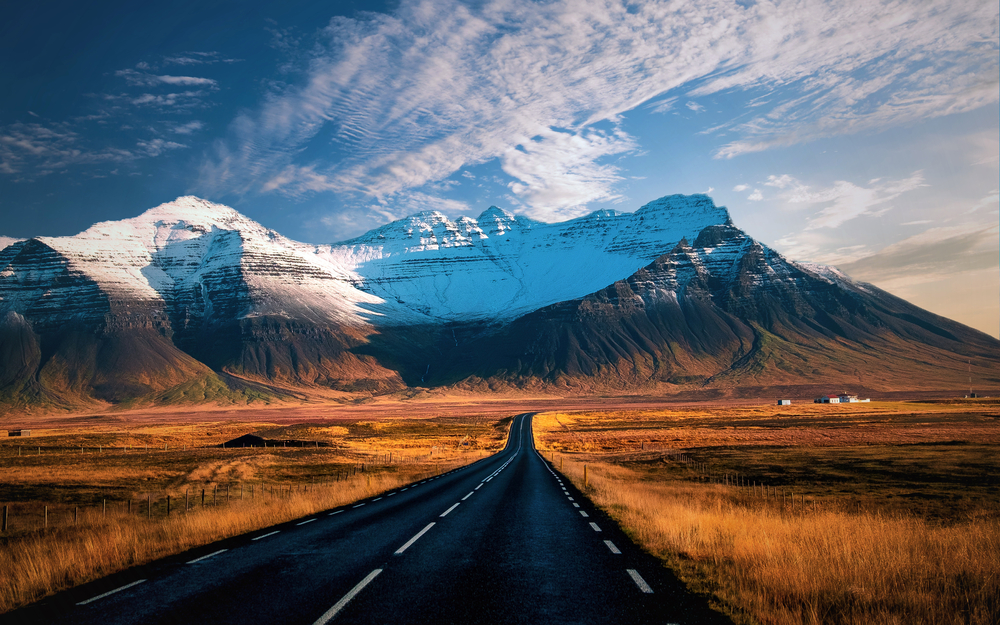
Can You Drive The Ring Road In The Winter?
Driving the Iceland Ring Road is more easily accomplished in the summer when the weather is more favorable and you have nearly 24 hours of daylight to drive and explore.
It is possible to drive the Ring Road in the winter but you just have to be flexible and adaptable as your trip has the potential to be greatly affected by the weather. Thankfully, much of the Iceland Ring Road is paved, but there are a few gravel sections that are trickier to drive.
There are also stops on this Iceland Ring Road itinerary that require driving down gravel side roads that are far more unpredictable to drive. It’s definitely possible that sections of the Ring Road will be temporarily closed down due to weather and road conditions during your trip. Keep an eye on the road conditions and adapt your trip accordingly.
You’ll also need to use extreme caution when driving in Iceland on icy roads or when driving during a snowstorm. We highly suggest renting a 4×4 car which should come equipped with winter tires.
As long as you’re willing to make changes in your schedule as circumstances present themselves, the winter in Iceland can be an absolutely beautiful time to take in the country’s natural beauty along the Ring Road.
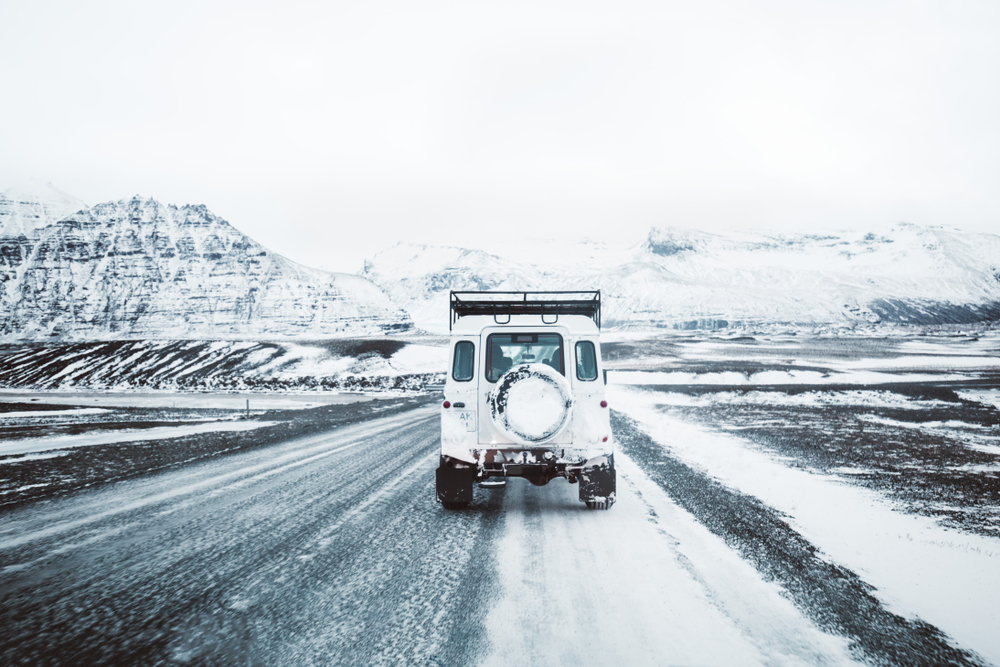
Iceland Ring Road Map
For such a long, extensive trip with so many stops, it might be helpful for you to see your route on a map. We’ve provided the following Iceland Ring Road map below so you can get a better idea of where each stop is located and which region of the country it can be found in.
Each and every stop on this list is included as a small photo on this map of the Ring Road in Iceland.
You can easily download it and keep it for your records. You can even print it out and bring it with you to refer to it as you are trying to find each spot!
We wanted to make this Iceland Ring Road Map as visual as possible so that you know what you are looking for when you are at each stop.
We know that the photos are a bit tiny, but there were just too many stops and we didn’t want to leave any out! If you take it on a trip to Iceland, send us an email to victoriayore@gmail.com and show us!
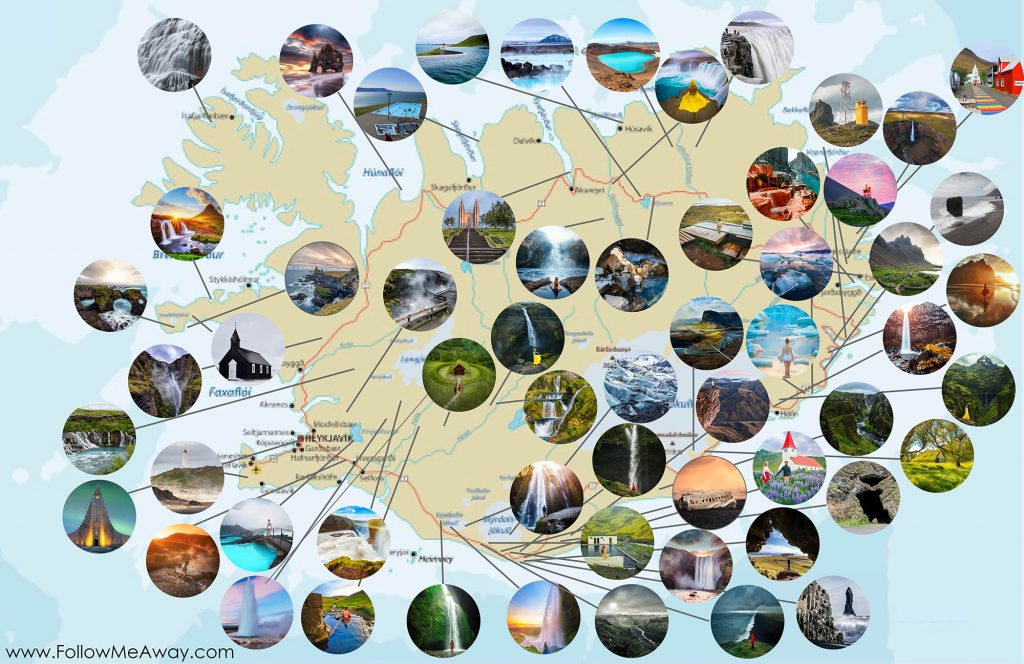
Best Iceland Ring Road Stops In The South
Stop 1: Begin Your Road Trip At Iceland’s Oldest Lighthouse, Reykjanesviti
To kick off your Iceland Ring Road itinerary you’ll head straight from the airport to a stop a little ways off the Ring Road, but worth visiting.
We’re talking about the Reykjanesviti Lighthouse, the oldest lighthouse in Iceland built in 1907. Technically Reykjanesviti is actually a replacement lighthouse constructed after the previous lighthouse in the area, built in 1878, fell victim to earthquakes.
The lighthouse isn’t particularly unusual being very traditional in design and white in color, though its views of the raging Atlantic Ocean are wonderful. You’ll find it perched on Baejarfell hill standing guard over the Rekjanes Peninsula. Unfortunately it’s not possible to go inside the lighthouse, but a climb up the hill to its base will give you the best views.
This is one of the best things to do in Reykjavik since it is so near the city!
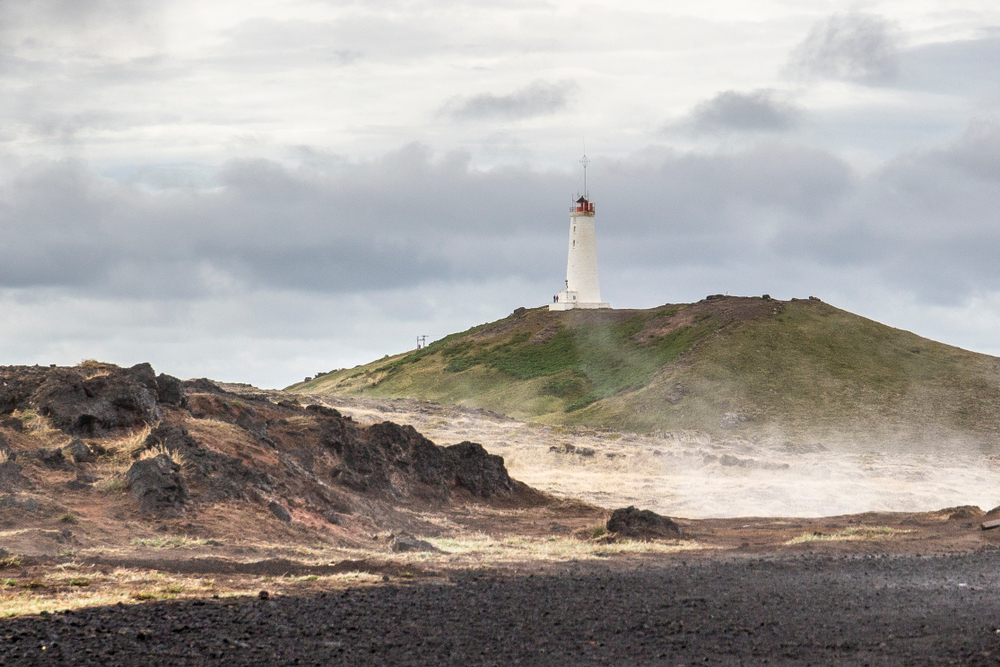
Stop 2: Relax In The Healing Waters Of The Blue Lagoon
The Blue Lagoon is also not exactly on the Ring Road, but it is an experience that can’t be missed. It is one of Iceland’s most famous attractions/activities and a hot spot for tourists and even celebrities.
You’ll need to book well in advance on the Blue Lagoon website to guarantee a time slot due to a heavy increase in tourism. Despite the crowds and hefty prices, this is an experience that is definitely worthy of a visit at least once.
This geothermal slice of heaven is surprisingly not a natural hot spring. It is a man-made lagoon resulting from the activity at the nearby geothermal power plant, Svartsengi .This stop is in a great area and actually on our list of Best Places To Stay In Iceland. In this post, we offer suggestions for where to stay around the Ring Road!
Though that sounds less than glamorous, the water is truly wonderful, safe to enjoy and is renewed every 48 hours. While the mineral richness of the water is wonderful for your skin, it’s terrible for your hair. Keep your hair tied up if it’s long or be prepared to condition it excessively.
The Blue Lagoon now includes a bar in the lagoon itself, a number of restaurants on the property, as well as additional spa experiences you can pay extra for. This is definitely a pricey experience as the lowest entrance package is $55-$95 depending on the time of day you visit, but there’s no doubt you’re in for a wonderful time in these blue waters surrounded by natural lava and moss.
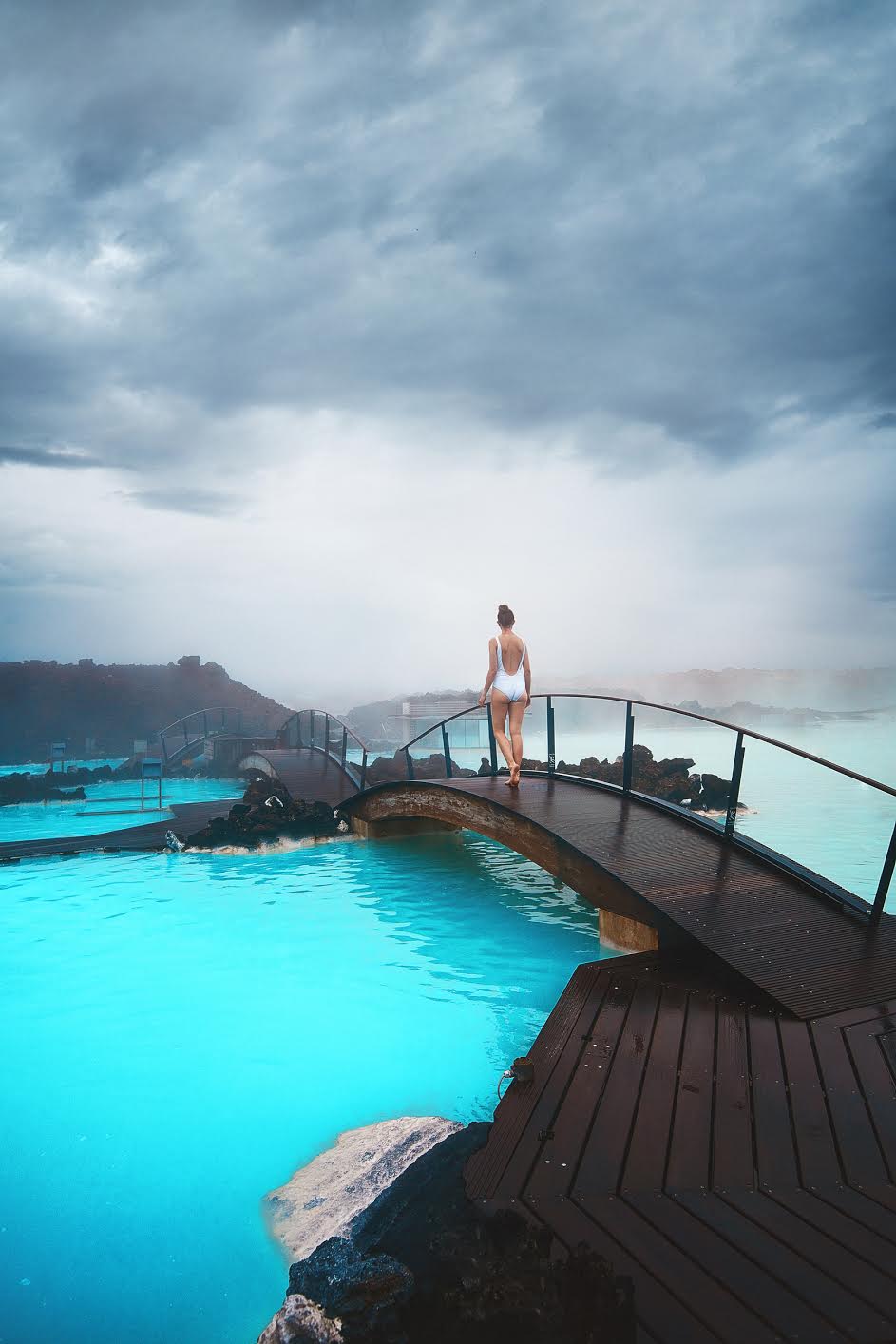
Stop 3: Have Your Camera Ready To Catch The Frequent Eruptions Of Strokkur
Your next stop will be Geysir, the geothermal hot spot in the Haukadalur Valley. The once impressively powerful Geysir is currently inactive having only naturally erupted in recent history from the force of earthquakes. It is also one of the best day trips from Reykjavik if that is where you are coming from!
Even while active, its eruptions throughout history were sporadic. It is unclear what will set off its next eruption should that ever occur, so don’t expect it to erupt when you visit. The new star of the show is its neighbor Strokkur, which still erupts at roughly 5-7 minute intervals.
Crowds of tourists gather around Strokkur in anticipation of its burst of water and steam shooting up into the air. You can usually anticipate the eruption. You’ll notice a disruption in the water as it bubbles, retracts and then springs into action.
Have your camera ready. Your best bet is to videotape the eruption or take bursts of photos to track the progression of the eruption. It is one of the best places to see on your Iceland Itinerary!
While the main attraction is the geyser, the surrounding landscape is full of pots of boiling water. As you might expect, the water is dangerously hot to the touch, so steer clear and enjoy the natural phenomenon at a safe distance.
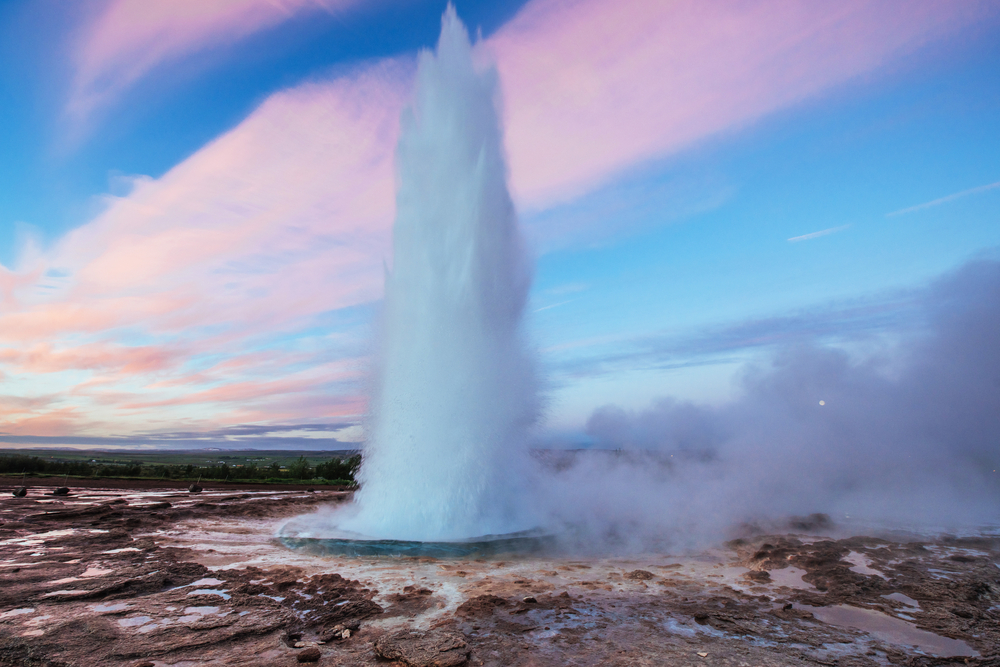
Stop 4: Catch A Rainbow Arching Over The Impressive Gullfoss Waterfall
Gullfoss Waterfall is another stop along Iceland’s Golden Circle. It is iconic, incredibly popular, and often the first of Iceland’s numerous, impressive waterfalls that tourists see on their first trip to the country. The waterfall, which stems from the Hvita River, falls in two sections, the last of which drops into a deep crevice.
In the summer months it is common to see a rainbow arching over the waterfall, earning it the name Golden Waterfall. Though Iceland spoils you with an abnormally large number of impressive waterfalls, Gullfoss is rightfully among the top. It’s an impressive sight at any time of year.
The waterfall has both upper and lower viewing platforms, and we suggest spending some time at both. Though you can view the waterfall along its full length, the path to the lower viewing platform ends right by the waterfall itself sending spray from the powerful falls in your direction.
Though the water droplets can be chilling, being that up close to such a remarkable force of nature provides for an intimate and thrilling experience. On the upper viewing level you’ll also find a café and shop selling food, drinks and Icelandic products.
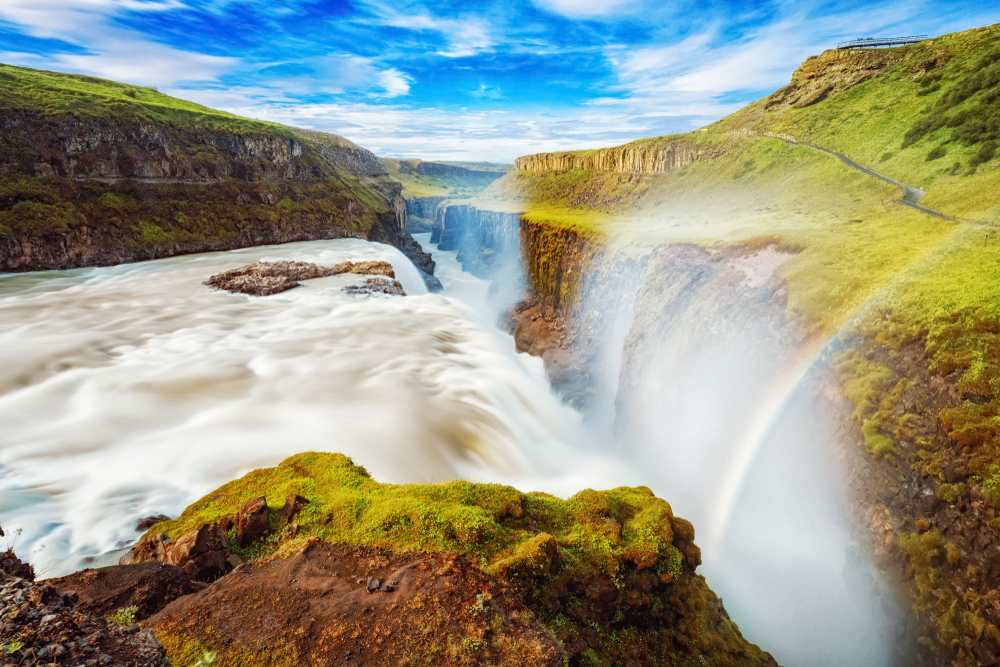
Stop 5: Marvel At The Most Brilliant Natural Blue Waters Of Bruarfoss Waterfall
It’s hard to believe a waterfall like Bruarfoss exists naturally. The blue of the water is so brilliant it almost looks as though a bucket of paint was thrown in to color the water. It’s spectacular.
The waterfall is quite small compared to many of Iceland’s giants, but Bruarfoss has such a unique look that it stuns despite its size. Bruarfoss has become an increasingly popular spot for visitors, however the fact that it’s hidden and requires some hiking and searching to reach means only the most motivated tourists seek it out.
Getting to Bruarfoss is a little more challenging these days as the shorter path that once existed through private property has now been shut down. Instead you’ll park in the designated parking lot labeled “Bruarfoss Waterfall Official Parking” on Google Maps. From here you’ll hike roughly two miles to the waterfall.
Most of the hike follows the Bruara River, passing a couple smaller waterfalls along the way. Though the walk is longer now, it is a beautiful walk through Iceland’s remarkable nature with a picturesque end result. Visiting Bruarfoss in the winter can be beautiful too, but remember to bring crampons in case the path to the waterfall is icy.
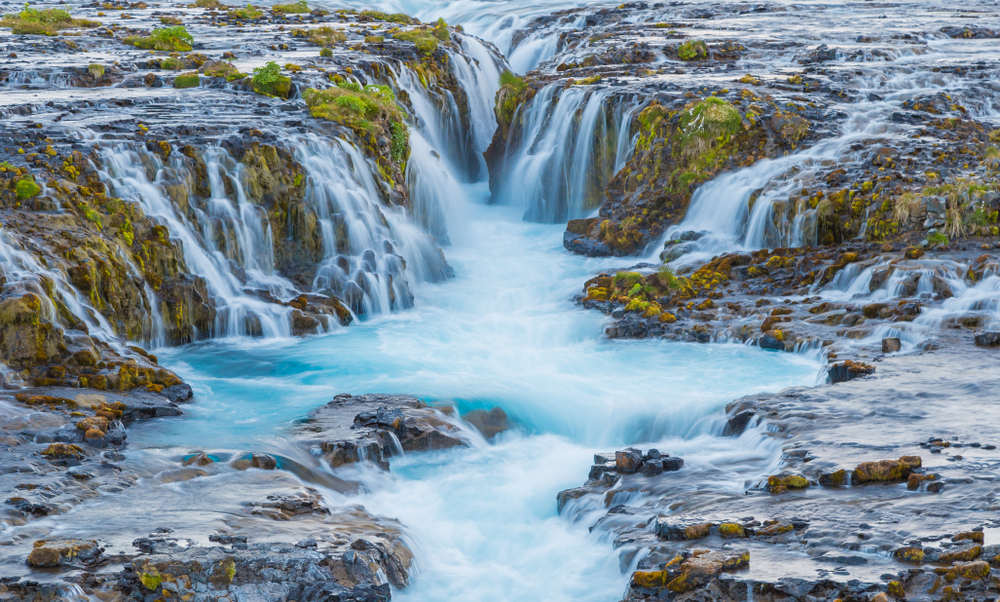
Stop 6: Soak In The Hrunalaug Hot Springs Surrounded By Natural Beauty
Everything about the Hrunalaug Hot Springs is picturesque and ideal from the consistently comfortable water temperature to the beautiful surrounding nature.
However recent surges in tourists and large tour buses have worn down the site to the point where the owner considered bulldozing it down. The natural hot spring was built up to accommodate humans, but is very small and not designed for large groups of people.
A little turf hut acts as a changing room. Behind the hut is a small two person rectangular hot pot.
To the left of the changing room as you face it is a slightly larger pot, but even that only holds 8-10 people. Early morning or late evening is the best time to visit the hot spring to avoid the biggest crowds.
We cannot express the importance of keeping this location clean, being respectful, and picking up after yourself.
The changing hut and pools are generally clean and well maintained mostly thanks to the owner who comes by occasionally to see to its upkeep. But as we mentioned, this wonderful hot spring is at risk of being shut down for good, so please play your part in preserving it so it can remain for future visitors to enjoy.
Read next: Tips For Visiting Hrunalaug Hot Springs
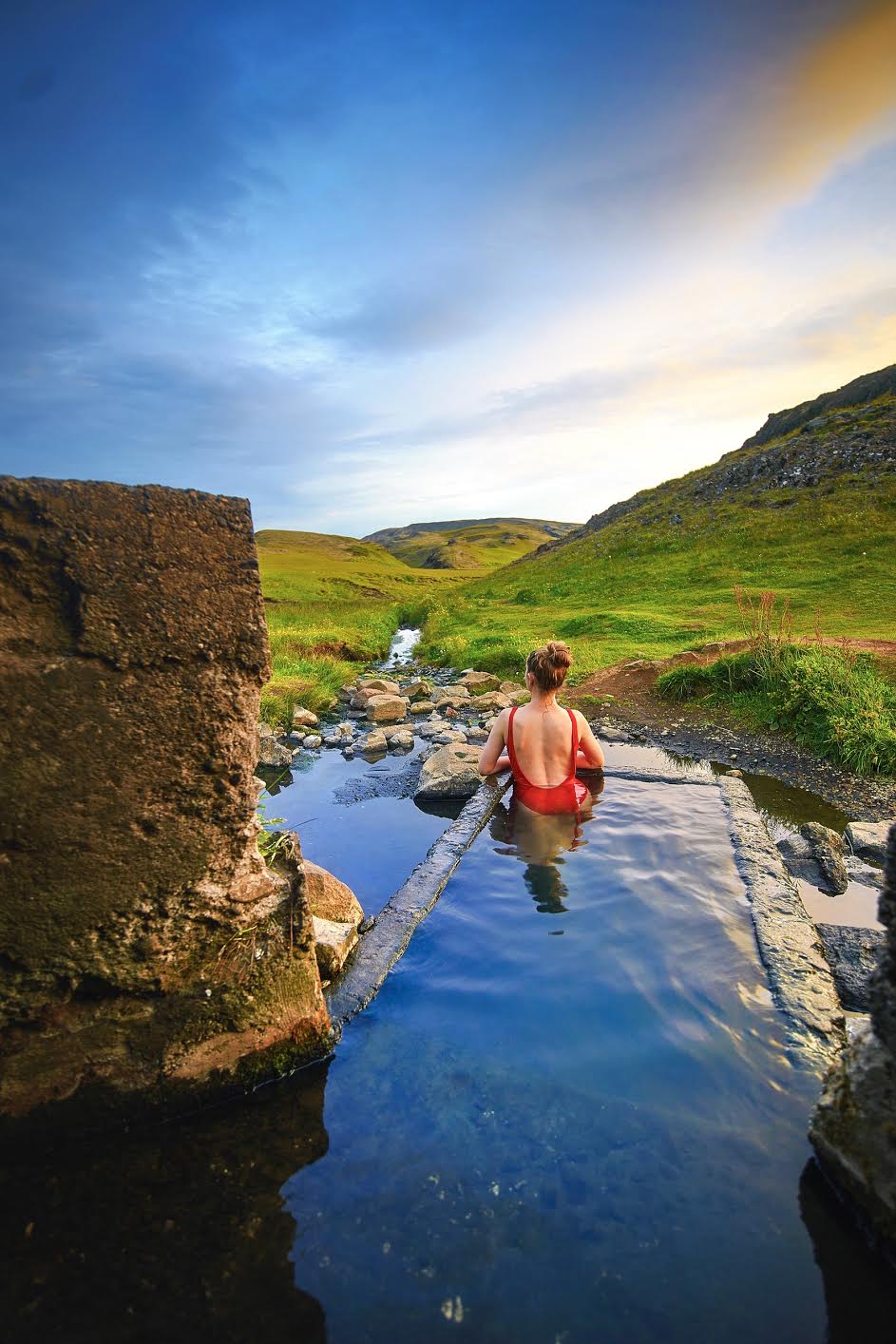
Stop 7: Marvel At The Construction and Detail Of The Þjóðveldisbærinn Saga-Age Farm
Have you ever wanted to learn more about how the Vikings lived? Well now is your chance at the Þjóðveldisbærinn Saga-age farm, an impressive replica of Stöng, the excavated manor farm in Þjórsárdalur.
The reconstructed Settlement farm was built in honor of the 1100th anniversary of the Settlement of Iceland and opened in 1977. The idea was to provide an example of a medieval Icelandic farm, and Stöng was a great representation of a farm from that time period.
Stöng was located dangerously close to the volcano Hekla. It is thought that the farm and surrounding settlement were destroyed and abandoned after the 1104 Hekla eruption, however Hekla also erupted many other times in later years, so the exact time of its final destruction and abandonment is unclear.
Despite being covered in white volcanic ash, the remains of Stöng underneath were remarkably well preserved.
The farm was reconstructed with much love, care, and attention to detail in an attempt to preserve an important piece of Icelandic history. Of course without a full original to copy, there are aspects of the reconstructed work that had to be imagined, estimated, or pulled from story and folklore, but by all accounts the finished result is remarkably accurate.
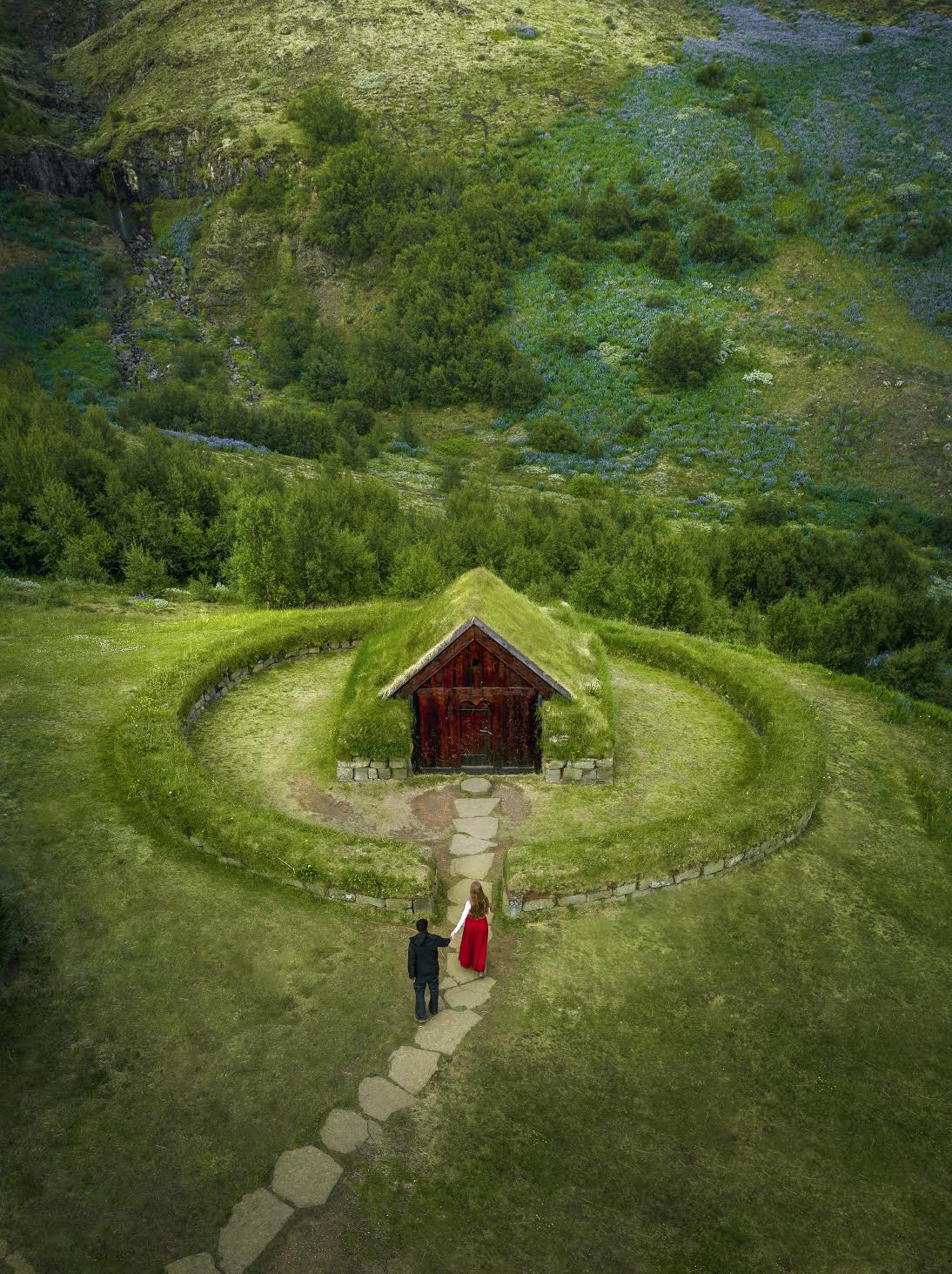
Stop 8: Feel The Power Of One Of Iceland’s Highest Waterfalls At Haifoss
On the edge of the South Iceland highlands sits Haifoss, one of the country’s highest waterfalls at an impressive 400 feet. It thunders down right next to its neighbor waterfall, Granni. Though Granni’s flow is slightly less powerful, the two waterfalls side by side are a sight to behold.
The waterfalls are located in a gorge created by the Fossa River. It is possible to hike down to the falls if you’re spending a significant amount of your day at the waterfall and its surrounding valley, but the view from the top is incredible, and easily accessible from the parking lot. You can walk along the edge of the gorge taking in the waterfalls from multiple viewing points.
In the winter, Haifoss is usually inaccessible unless you are driving there in buses or jeeps designed for winter weather and icy gravel roads. Even in summer, the gravel roads are rocky, full of potholes and require slow driving and patience.
With the rocky roads and its distance from the more popular South Coast tourist spots, Haifoss is hardly ever crowded. There’s always plenty of time and room to take pictures and experience the waterfalls in all their glory.
Whether you have two weeks or less than a week to tackle the Iceland Ring Road, we suggest making time for Haifoss. With views this spectacular, you won’t regret making the bumpy drive.
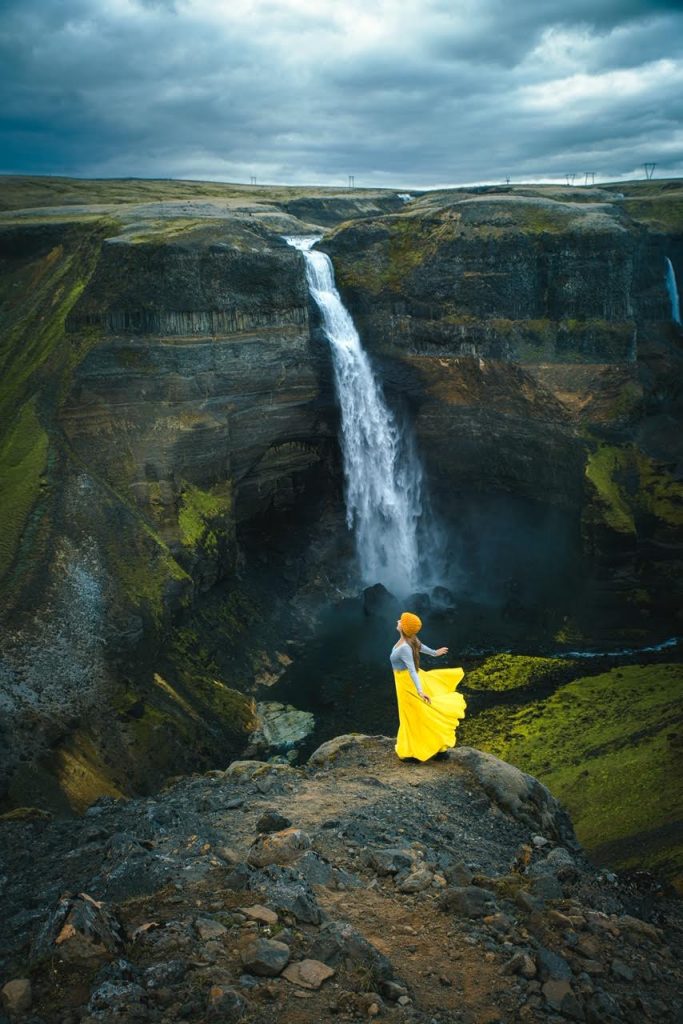
Stop 9: Wander A Picturesque Valley At Gjain
Gjain is a stunning valley particularly in the summertime when the vegetation is at its peak. You’ll find a collection of small waterfalls, brilliant blue pools of water, carved out shallow caves, green growth, flowers and birdlife. When the weather is nice, it’s the perfect place for a picnic.
Because it’s a valley, it feels very private and secluded giving you a welcome peace and quiet to your experience. You’ll hardly ever find crowds here as it’s off the main road and not a stop that general tour buses make. The valley is beautiful at other times of year as well but it can just become harder or impossible to reach in the winter as the roads and paths turn icy.
Getting to Gjain is fairly straightforward from Haifoss. Continue back down the road the way you came then turn right when you reach the fork in the road instead of heading all the way back to road No. 32.
To reach both Gjain and Haifoss, it’s recommended you have a 4×4 car with ground clearance because of the bumpy roads. The drive itself isn’t anything particularly spectacular as you pass through expanses of lava fields and rock, but it makes arriving at this hidden oasis even more spectacular and magical.

Stop 10: Hike To The Reykjadalur Hot Springs To Bathe In A Geothermal River
If you’ve ever wanted to bathe in a hot river, you’re sure to enjoy the Reykjadalur Hot Springs. The hike to the hot springs is roughly 45 minutes-1 hour, and is easy to moderately difficult. The well-maintained, clearly marked path starts with a steep uphill climb before leveling out.
Your hike will take you through a valley filled with steam, past a cascading waterfall and many grazing sheep followed by the distinct smell of rotten eggs from the sulfur indicating you are close to the hot spring. Don’t touch the boiling water. The water you’ve come to enjoy is mere steps away.
You’ll change on a wood platform with partitions. Privacy is lacking, but no one cares. Everyone is there to relax and have a good time.
For the deepest pockets of water, sit by the rock piles dividing the river into sections. In summer, the water in this section of the river resembles that of a Jacuzzi.
As the weather gets colder, you may need to hike a little further upriver to find a spot warm enough to enjoy for extended periods of time. Arrive in the early morning or late evening (when you can enjoy the midnight sun in the summer to avoid the biggest crowds).
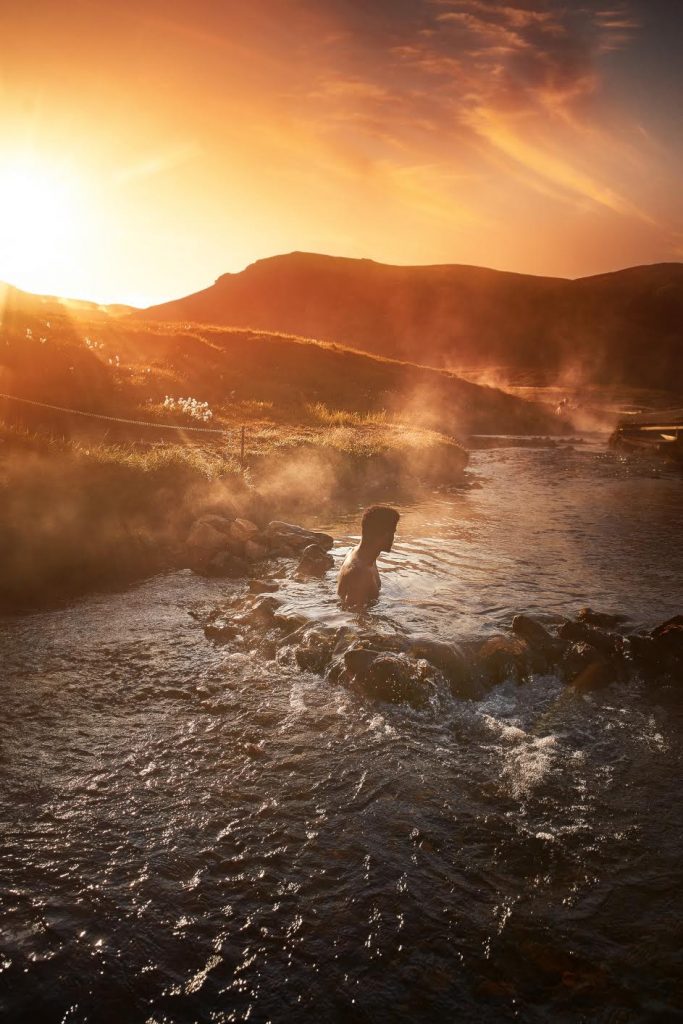
Stop 11: Take A Walk Behind The Stunning Seljalandsfoss Waterfall
Though Iceland is graced with an endless display of stunning waterfalls, the 200-foot Seljalandsfoss is unique because you can walk behind the waterfall. A path leads from the parking lot up to the front of the waterfall, and then loops around the sides and back so you get a view of the waterfall from every angle.
We suggest wearing raingear, as you’ll get wet, particularly on a windy day. It is entirely worth walking the loop though, and being that up close and personal makes you appreciate the sheer size and power of the waterfall.
The waterfall is relatively narrow, but its power is mighty. In the summer, the cliff and ground surrounding Seljalandsfoss are a brilliant green, and everything is dotted with yellow wildflowers creating a colorfully picturesque landscape.
Though the path gets wet, it is a well-marked path, and easy to navigate. In the winter, when the snow turns to ice and the path gets slippery, the path is often partially closed off. This is for your own safety.
Don’t try and circumvent the restricted area. Though closures may alter your experience, it isn’t lessened. Seljalandsfoss is beautiful even in winter.
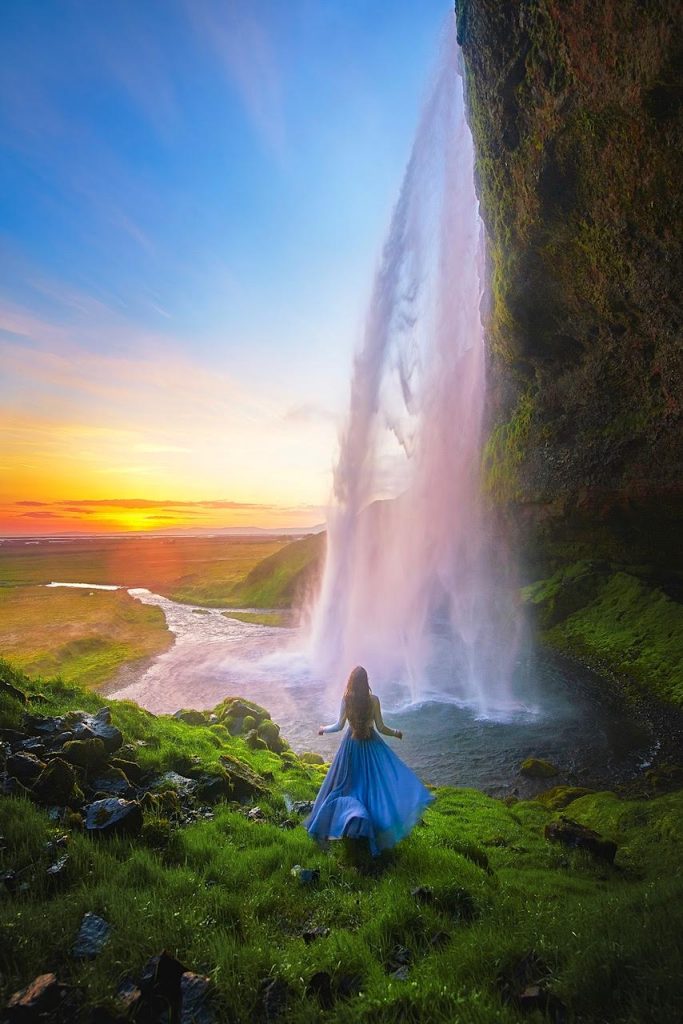
Stop 12: Find Seljalandsfoss’ Hidden Neighbor, Gljufrabui
Gljufrabui is the hidden, often overlooked gem next to Seljalandsfoss. From Seljalandsfoss, head right (if you’re facing the parking lot), and walk until you hit the campground. On your right will be a sign for the waterfall, and you’ll see a cavern with a river running through it.
To get to the waterfall you’ll walk from rock to rock through the river, so be prepared with waterproof boots or a change of shoes. Occasionally the water level is low enough for the rocks to stick out enough for you to avoid getting wet, but it’s better to come prepared.
Once inside the cavern you’ll find a beautiful waterfall that looks as if it’s pouring through a skylight in nature’s ceiling. Standing below, you are surrounded and consumed by the mossy green and sparkling water in the cavern.
A giant boulder in the middle of the cavern is easy to climb and perfect for taking pictures. You’ll exit the cavern that same way you came in. You may have to wait if someone else is trying to enter the cavern at the same time.
It’s also possible to view the waterfall from above, looking down on the waterfall from the skylight opening. The pathway up the hill though is steep and often muddy and slippery so use caution.

Stop 13: Enter A Ravine To Find The Magical Nauthusagil Waterfall
Nauthusagil remains unknown to many, possessing the secluded charm that Gljufrabui once had. The South Coast is famous for its stunning waterfalls, one right after the other, and hidden back in a magical ravine you’ll find one more.
You’ll definitely want to wear waterproof boots or boots you don’t mind getting wet as you’ll be following the river through the ravine and will need to step through it at times. Shoes with a lot of grip will help too for climbing up the side of the miniature waterfall along the way with the help of a chain on the ravine wall.
It’s certainly an adventure scrambling through the ravine. The rocks can be slippery, but as long as you stay alert and use the chains for assistance where needed, you shouldn’t have problems safely reaching the waterfall where you’ll find the reward is well worth the journey.
The waterfall itself resembles Gljufrabui in many ways. It’s small compared to Iceland’s more prominent waterfalls, but has its own mystical beauty.
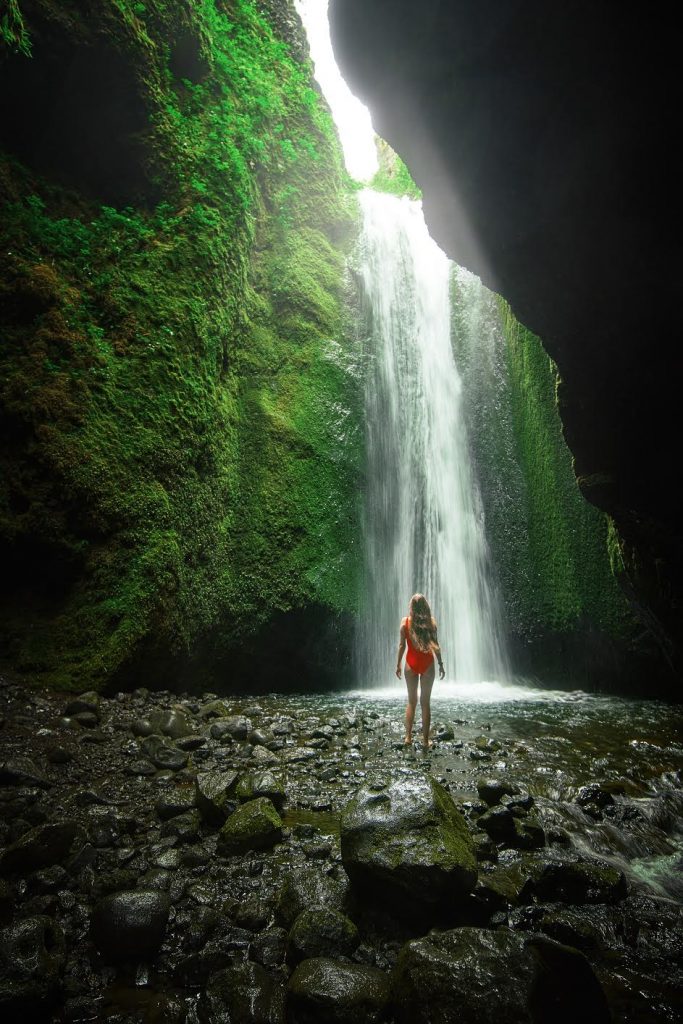
Stop 14: Hike And Camp In The Rugged Valley Of Thorsmork
Thorsmork (Thor’s Valley) is a stunning nature preserve in the highlands that is perfect for hiking, camping, and general rugged mountain and forest adventuring. Many tourists are anxious to get a glimpse of this spectacular valley, however getting here is the most difficult part.
Though it is possible to drive into Thorsmork yourself, you absolutely have to be driving a 4×4. Even then that doesn’t guarantee you’ll be driving a car suitable for the river crossings you’ll have to tackle. As a result, hiring a local guide to take you into Thorsmork in a superjeep might just be the most logical way to go.
Technically you can also hike into the valley, though that requires a multi-day journey that is certainly not for the faint of heart or casual hikers. You’ll have plenty of hiking opportunities once you’re in the valley, including a particularly wonderful hike to the summit of Valahnukur where you’ll be met with spectacular views.
There are a number of excellent campgrounds in Thorsmork. The Volcano Huts are a particularly popular option.
And if you’re lucky you might even catch a glimpse of an arctic fox. They are certainly present in the highlands, but are incredibly elusive and hard to spot so count yourself lucky if you see one!

Stop 15: Take A Swim Or Just Appreciate The Beauty Surrounding Seljavallalaug
The Seljavallalaug Swimming Pool is without a doubt beautiful. It is tucked away, hidden smack dab in the middle of spectacular, mossy green mountains and small trickling waterfalls.
Though the structure is man-made, the water is fed by a natural hot spring. A 20-minute hike/walk back into the mountains from the parking lot will find you face to face with this picturesque pool.
You can swim in this pool, however the swimming experience is not quite as magical as it may appear to be. The temperature of the water is colder than many of Iceland’s other natural hot pots, hovering somewhere between 20 and 30°C. This means it’s not particularly comfortable to stay in for extended periods of time.
The pool is also covered in slippery algae and is only cleaned once a year, so for those with sensitive immune systems this may not be the body of water you want to expose yourself to. Unfortunately the small changing rooms are not well kept either.
The site is still remarkably beautiful and worth the short hike to see and photograph. If you’re willing to brave the pool conditions, by all means enjoy a swim. At the very least though it provides for a scenic adventure.
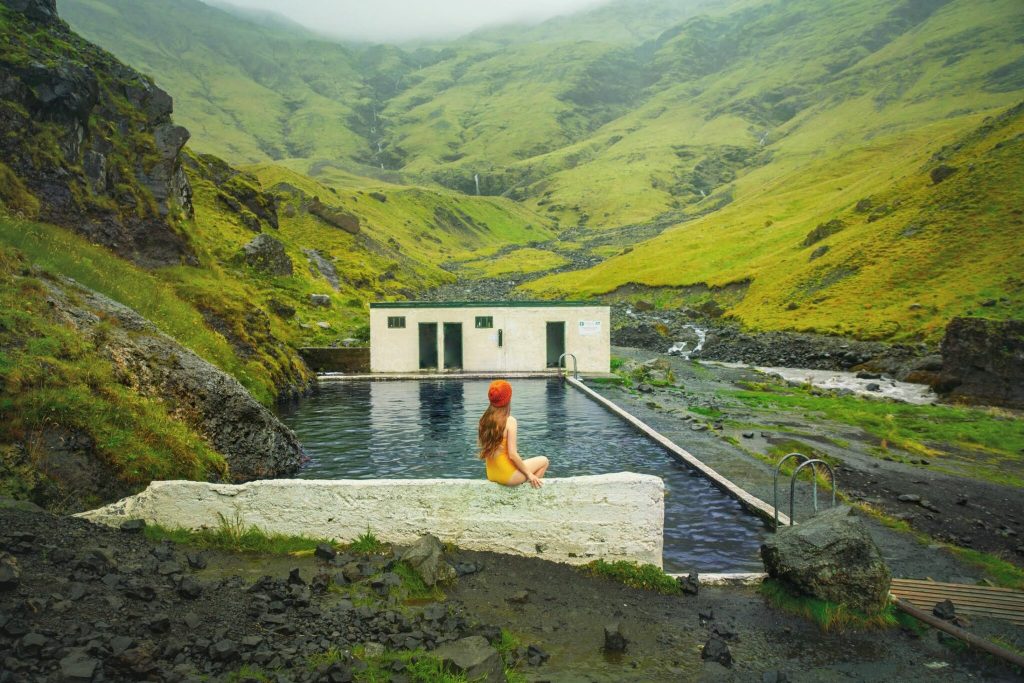
Stop 16: Climb The Stairs For a View From The Top Of Skogafoss Waterfall
At 197 feet, Skogafoss is roughly the same height as Seljalandsfoss but its width is an impressive 82 feet. The Skoga River flows along a wide, pebbled path leading right up to the waterfall.
The waterfall is forceful, and you will get unrelentingly sprayed as you approach it from its base, so you’ll want to consider wearing water resistant clothing. But the feeling of standing that close to such a powerful force of nature is incredible. You might even spot a rainbow arching over on a sunny day.
By walking up roughly 500 stairs you can also view the waterfall from above. The quadriceps workout is well worth the view. From the viewing platform you can see the Skoga River flowing to the top of the waterfall before plummeting over the edge.
From here you can either head back down the staircase to the parking lot or embark on an extended day hike back along the Skoga river into the valley to marvel at additional waterfalls. Assuming you’re returning to the parking lot, you’ll turn back to face the staircase and be greeted with a beautiful, sprawling view of South Iceland below.

Stop 17: Hike Back Into The Valley To Find Skogafoss’ Less Frequented Neighbor, Kvernufoss
Next door to Skogafoss is the waterfall Kvernufoss. Fewer tourists know of its existence, but it’s certainly not lacking in beauty.
You’ll take the same exit off the Iceland Ring Road as you would to get to Skogafoss and continue straight down Skogar to the end of the road and turn right. Park near Hotel Edda and walk the rest of the way into the valley.
In the summer, it takes about 10-15 minutes to reach the waterfall. The walk is comfortable, requiring very little in the way of elevation hiking or rocky terrain. From the hotel you’ll climb a short ladder over a fence and follow the path back into the valley.
The waterfall is similar in looks to Seljalandsfoss, however unlike Seljalandsfoss, the walking path doesn’t wrap all the way around the back, and at 98 feet it is also much smaller. The path ends right alongside the waterfall and provides you with plenty of excellent viewing spots. The valley is green and lush in summer, and sparkling white in winter.
Best of all, it’s not overcrowded with tourists. In the winter months, the path can be icy and dangerous.
Bring crampons to stabilize your feet on the slippery ground and exercise caution. You might have to view the waterfall from farther away.
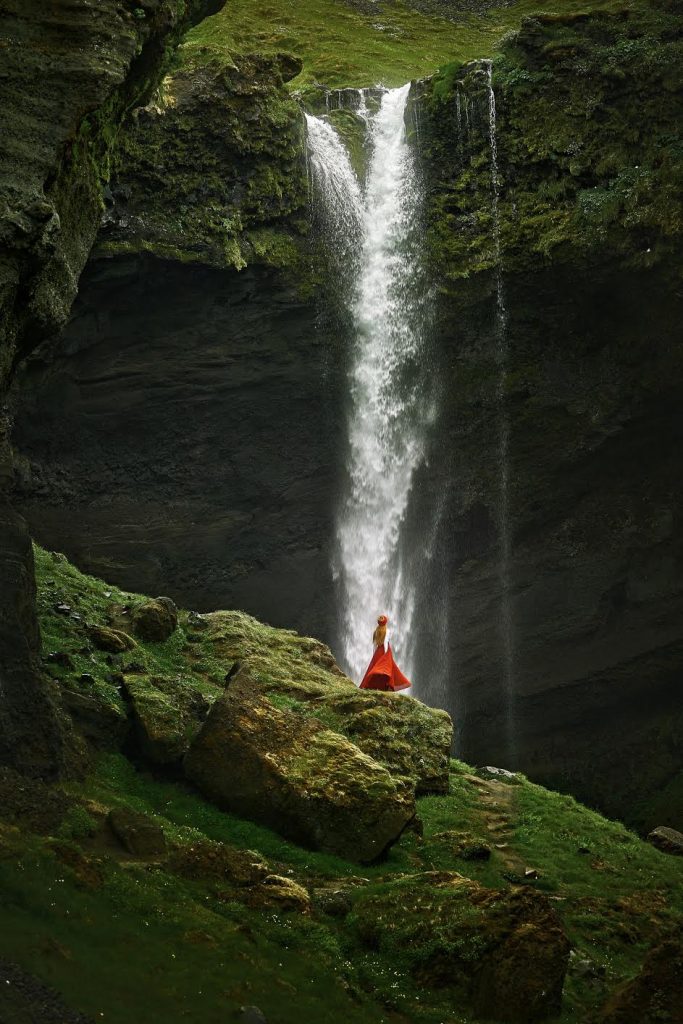
Stop 18: Wander The Eerie Remains Of The Solheimasandur Plane Wreck
A DC-3 US navy plane crashed on Solheimasandur Beach in 1973. Everyone survived, but the body of the plane was abandoned. The white wreckage of the plane lies in sharp contrast with the black sand of the beach, and together they make for hauntingly beautiful photographs.
From the parking lot, you’ll walk 2 miles to the crash site. The path is flat and relatively easy, but is roughly 45 minutes to 1 hour each way with very little to see besides vast expanses of rock and black sand.
The plane doesn’t come into sight until the end of your walk. Have your camera out ready to snap photos because the windows are slim for getting a shot of the wreckage without other people in the picture.
Despite the crowds, the wreckage stranded in the middle of the beach is uniquely beautiful. So if you’re willing and able to power through the walk, it’s worth the trip.
Recently a shuttle bus has been provided to the Solheimasandur plane wreck for 2500 ISK round trip or 1500 ISK one-way. This is a relatively new development that is still being tested out so don’t depend on it being a reliable mode of transportation on your trip.
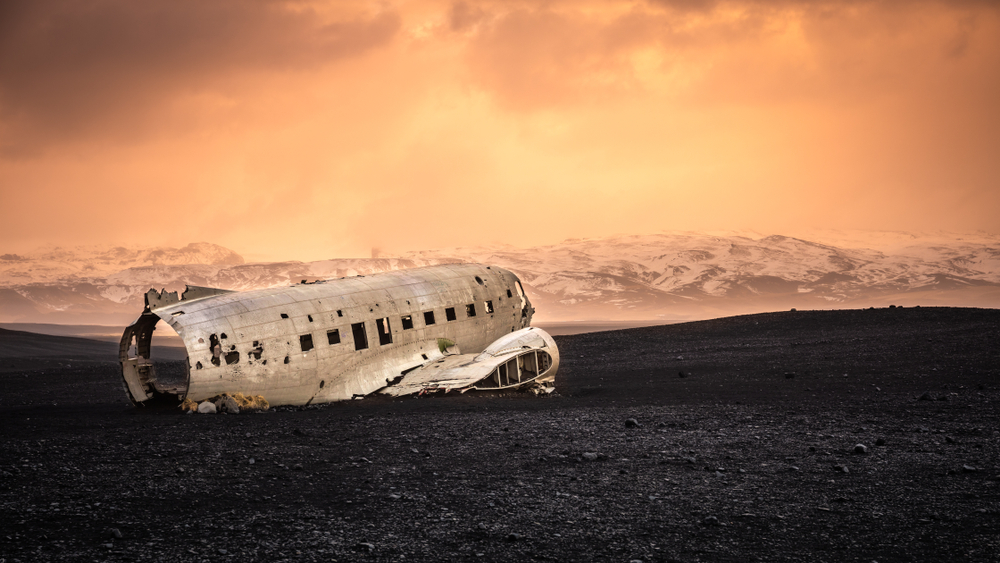
Stop 19: Take A Guided Glacier Hike Onto Solheimajokull
Solheimajokull is an outlet glacier of Myrdalsjokull that is slowly shrinking in size but is still mightily impressive. Solheimajokull is actually quite accessible. You’ll find it just off the Iceland Ring Road with a parking lot, café and a path that will lead you up to the jaw-dropping ice in 15-20 minutes.
From here you can take in the views, but do not walk out onto the glacier without a guide! Glaciers are so unpredictable as they constantly shift and crack. Venturing out on your own is incredibly dangerous. Don’t forget to check out our tips for Solheimajokull Glacier!
There are plenty of tour groups offering glacier hikes if you’d like to explore the glacier further, which if you have the time we definitely suggest you do. The guides are knowledgeable and trained to keep you safe leaving you to just enjoy the remarkable size and structure of the glacier you’re fortunate enough to experience up close.
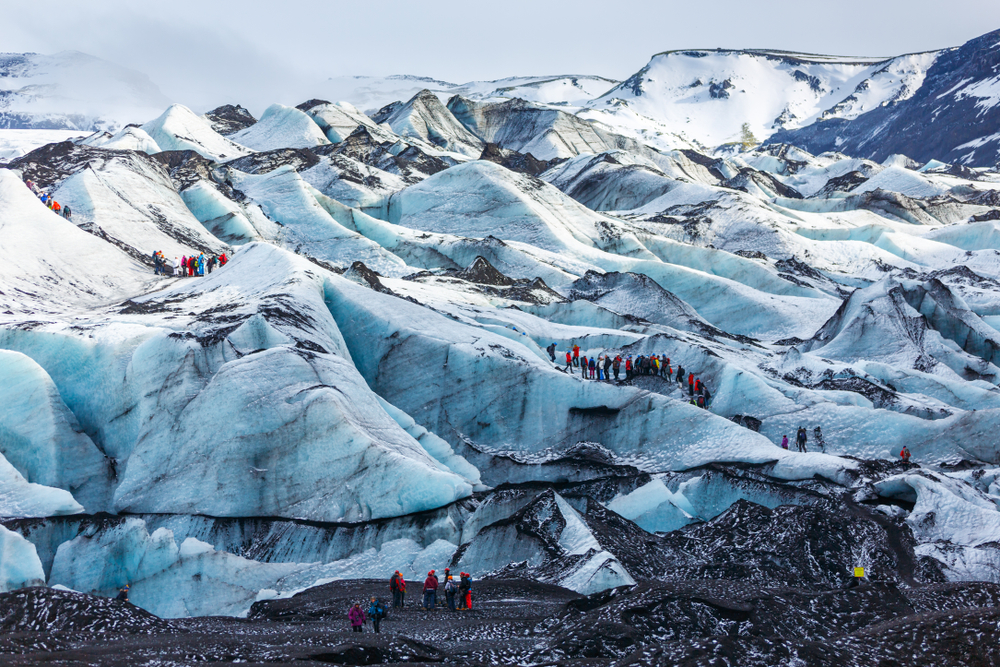
Stop 20: Enjoy Spectacular Birds Eye Views Of The Black Sand Beaches From Dyrholaey
Dyrholaey can be seen in the distance from the Reynisfjara Black Sand Beach, but it deserves its own stop. Getting to Dyrholaey requires driving for a short period on gravel road. It can be done in a 2×2 but having a 4×4 car on this portion of the drive is certainly helpful. This is truly one of the best things to do in Vik!
Dyrholaey is a peninsula that extends into an arched natural bridge, hence its name “Door Hole Island.” The arch is majestic and is even big enough for boats to sail through and small planes to fly through. What an experience that must be.
Expect a lot of wind, but the views from the top as you tower over the expansive landscape, are well worth pushing through the wind resistance. The area also includes a charming castle-shaped lighthouse notorious for the strength of its light, and spectacular views of long stretches of black sand beach and the distinctive basalt columns protruding from Reynisfjara Beach. It’s also a great spot for bird watching with the puffins being a particular favorite among birdwatchers.
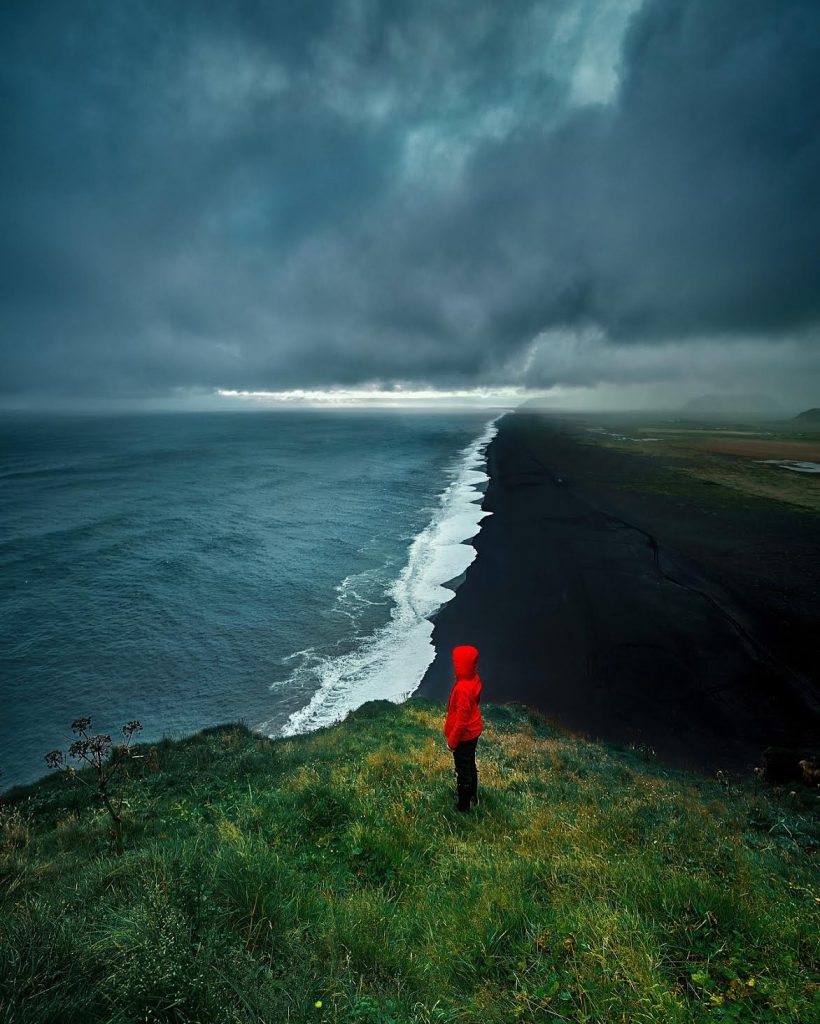
Stop 21: Climb Inside The Loftsalahellir Cave And Gaze Out At Dyrholaey
For a short break in your black sand beach viewing along the coast, we suggest making a stop at the Loftsalahellir Cave. A brief but rather steep walk will take you to this tuff rock cave that is known to be the historical meeting location for the Myrdal farmers. From inside the cave looking out you can see the majestic Dyrholaey Peninsula.
Loftsalahellir is becoming increasingly popular as a photography spot and as you sit inside the cave looking out at Iceland’s remarkable natural creations, it’s easy to see why. This will likely be a brief stop as you continue on your Iceland Ring Road trip to the Reynisfjara Black Sand Beach, but it’s one worth taking a moment to absorb and appreciate.

Stop 22: Climb The Basalt Columns At The Famous Reynisfjara Black Sand Beach
One of the most famous stops on your Iceland Ring Road itinerary is Reynisfjara Beach, known for its signature black sand and towering basalt columns. This beach is among Iceland’s most impressive black sand beaches, and was even featured in the TV show Game of Thrones.
There are so many incredible spots along the beach to enjoy. However you should be aware that the beach is developing a reputation for its large sleeper waves. So take your pictures, but be aware and don’t let your desire for the “perfect” photo affect your judgment.
The beach and its surrounding waters boast an impressive collection of rock formations including the cliff of basalt columns that seems to rise out of the sand. This is a prime photograph location and you’ll see many tourists climbing the uneven columns to pose for a picture.
When facing the roaring Atlantic Ocean, to the left are the Reynisdrangar rock formations. These pointy basalt pillars rise straight out of the ocean, like man made sculptures in the water. To the right is the Dyrholaey rock formation, an arched bridge-like formation with a large hole in the bottom.
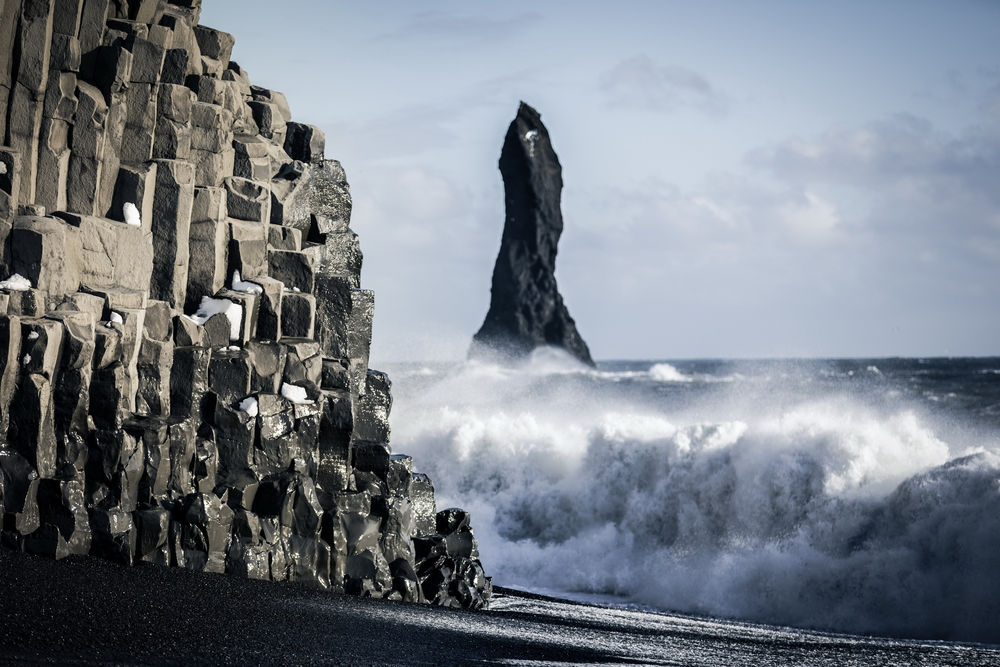
Stop 23: Take A Photograph Of the Red-Roofed Church In Vik
If you’re looking for a charming coastal town with gorgeous views, you’ve come to the right place. Vik is a very small town in Iceland with only about 300 inhabitants, but there’s plenty to enjoy in this picturesque area.
This is also a great place to stock up if you’re running out of necessities such as grocery store items or gas. You’re somewhat limited in what’s available but that’s to be expected in the more remote parts of Iceland. The town also has a public swimming pool if you’re interested.
If you’ve seen photographs of Vik, you’ve likely seen Vikurkirkja, the red and white church that has become almost synonymous with the town.
As you gaze at the beautiful church and its natural surroundings including the black sand of the beaches and the vibrant green grass, it’s easy to see why the church has become the focal point of so many pictures.
It’s also particularly noteworthy that due to the village’s proximity to the glacier-volcano Katla, Vikurkirkja has been designated an evacuation spot should the volcano erupt.
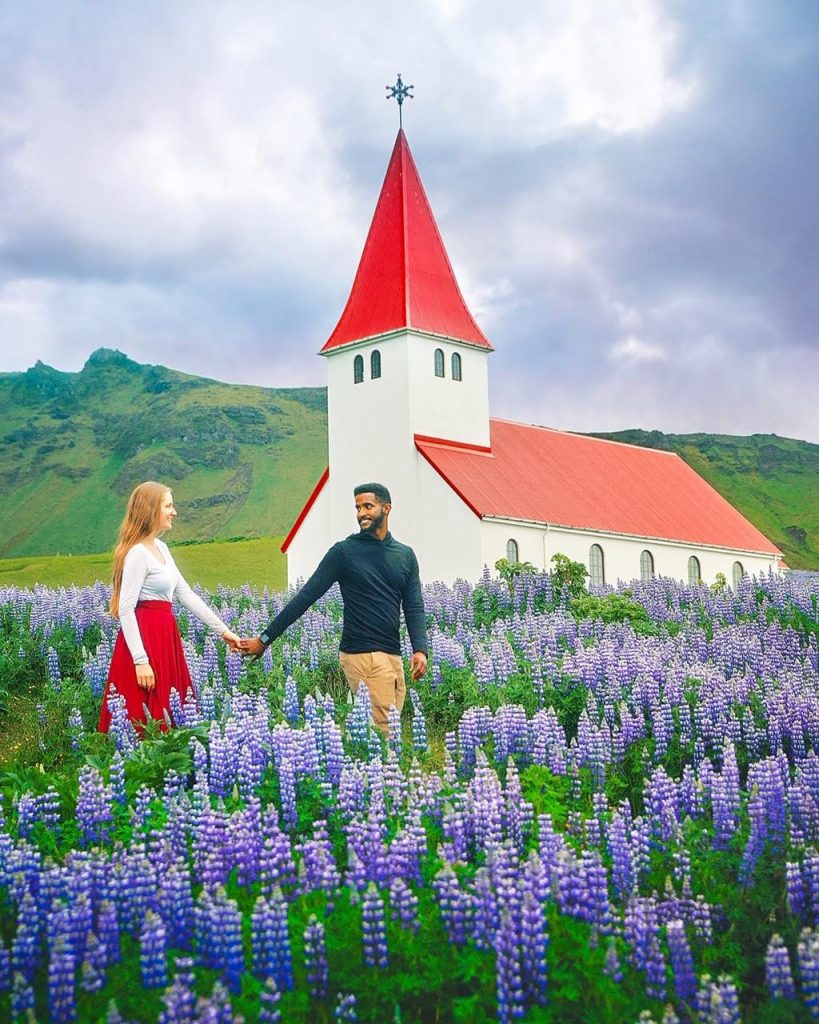
Stop 24: Hike Through The Mossy Green Canyon Of Þakgil Valley
Þakgil (Roof Canyon) Valley is a beautiful, lush, mossy canyon that erupts with vibrant green color in the summer. It’s located near Vik, with a gravel road leading up to its location. It is particularly loved for its small but spectacular campsite that offers tent camping, room for camper vans and small cottages.
The area is full of spectacular hiking trails including ones that lead you to wonderful views of the Kotlujokull Glacier and to ravines that culminate in beautiful waterfalls. And these are just a few of the hiking options.
From the campground in the heart of nature, you’ll find yourself blown away by the steep canyon walls that open out like a mountain parting itself to welcome you in. For an extra unusual experience, the campground has placed its picnic tables inside a natural cave.
If you’re up for camping this is the perfect place to spend the night before taking off on a hike in the morning and continuing your trip around the Iceland Ring Road in the afternoon. Even if you decide not to use the campground, the valley is beautiful and worth wandering through. This is truly one of the best photography locations in Iceland!
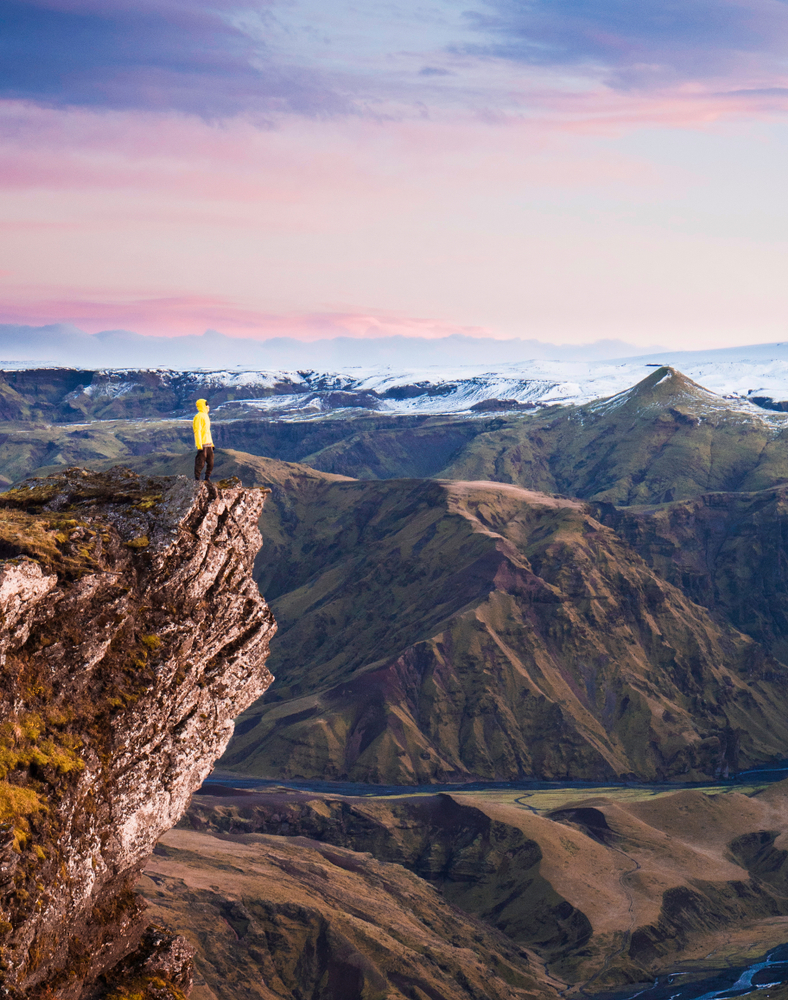
Stop 25: Hike The Hjorleifshofdi Promontory And Explore Inside The Yoda Cave
Hjorleifshofdi is a promontory just off the Iceland Ring Road that was named after the brother (Hjorleifur Hrodmarsson) of Iceland’s first settler (Ingolfur Arnarson). Hiking to the top of the promontory is a popular activity.
Signs at the base will show you a map with possible routes up the steep incline, one of which is more difficult than the other. You might try hiking up one side and down the other. There’s also a panel of historical information that is helpful to read.
At the peak, you’ll find Hjorleifur’s burial mound. Unfortunately, the ruins of his farm no longer exist as they were destroyed as a result of the erupting Katla volcano.
The top of this hike also gives you the most spectacular expansive views. In the summer, blooming lupines and green moss add to the scene. Expect to spend around 2 hours completing the hike.
The area surrounding the promontory consists of extensive areas of black sand beach, a couple of rock formations and a cave called Gygagja. You might, however, have heard of this cave referred to by its nickname “Yoda Cave.” The entrance to the cave is separated into two sections with the upper section bearing a striking resemblance to Yoda when looked at from inside the cave.
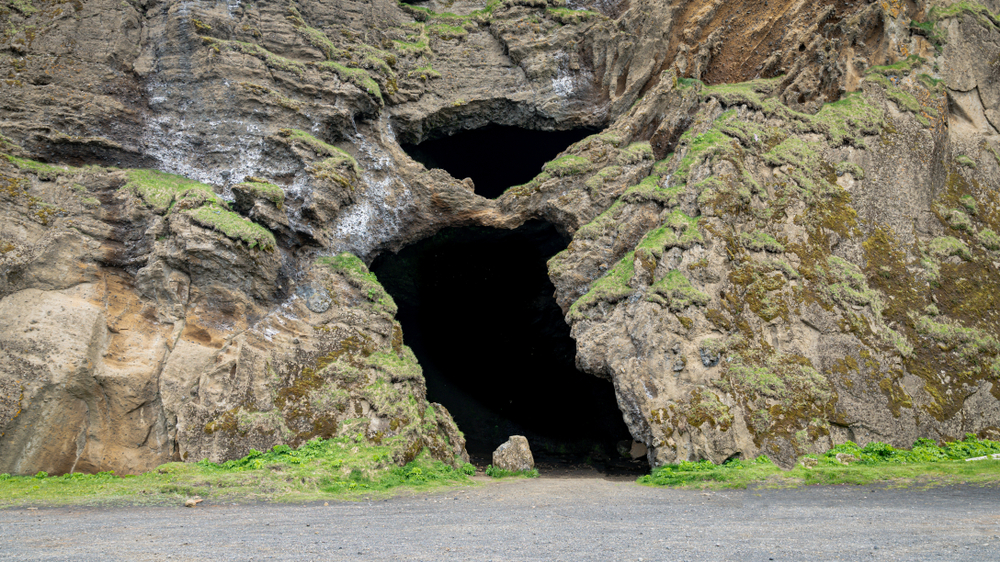
Where To Stay In South Iceland:
Affordable: Hotel Ork. Check rates: Booking.com
Mid-range: The Garage Apartments. Check rates: Booking.com
Luxury: Hotel Kría. Check rates: Booking.com
Best Iceland Ring Road Stops In The Southeast
Stop 26: Walk The Edge Of Fjadrargljufur Canyon For Breathtaking Views
The impressive 100m Fjadrargljufur Canyon is lined with vibrant green moss and blooming flowers in the spring and summer. In the winter, the landscape is sometimes covered in lacy snow making it a whole different kind of magical (just come prepared with crampons in case the path in icy).
A river runs down the center with a waterfall or two along the way. There are viewpoints along the edge of the canyon, but if the water level is low enough you also have the option of walking down to the base of the canyon along the water.
Walking the edge of the canyon is a breathtaking experience, but we implore you to please stay on the designated path. After Justin Bieber released the music video for his song “I’ll Show You” where he was shown frolicking around the canyon, tourism at this location surged and much of the natural beauty was destroyed by inconsiderate visitors. The canyon has on and off been closed to allow nature time to revive itself.
It’s also occasionally closed in the spring when the ice and snowmelt cause the path to be too muddy and dangerous. For now, the canyon is again open to the public but will only continue to remain open if people respect the environment and let nature thrive.
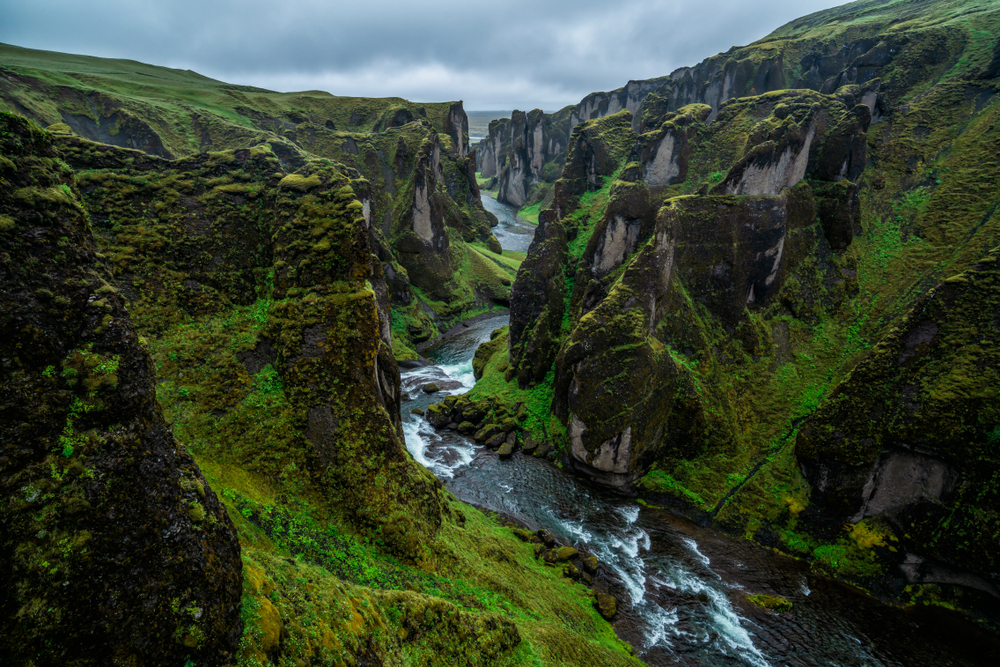
This is one of the BEST ROAD TRIPS IN EUROPE so you are in for a real treat and a memorable experience!
Stop 27: See The Turf-Roof Hofskirkja Church Blend Into Its Natural Surroundings
Iceland’s turf roofs have the unique ability to blend nature and man-made creation into one seamless landscape. Turf houses used to be an abundant sight, but now there’s a limited collection still in existence.
We suggest enjoying the beautiful turf roof of the Hofskirkja Church in Hof. This will likely be a quick stop, but it gives you a chance to take photographs of this charming church.
The sturdily built church was built to withstand Iceland’s unpredictable, harsh weather. We’re thankful it’s managed to hold up so visitors can enjoy its exterior construction today. Unfortunately it’s not possible to go inside the church, but after walking the perimeter of the church you can visit the adjacent cemetery.
In the summer, the whole area surrounding the church, including the gravesites, is covered in a lush green making the scene particularly picturesque and vibrant. In the winter, the scene takes on a more ominous, mysterious feel with leafless trees and browning grass. In either case it makes for an unusual and interesting stop along your route.
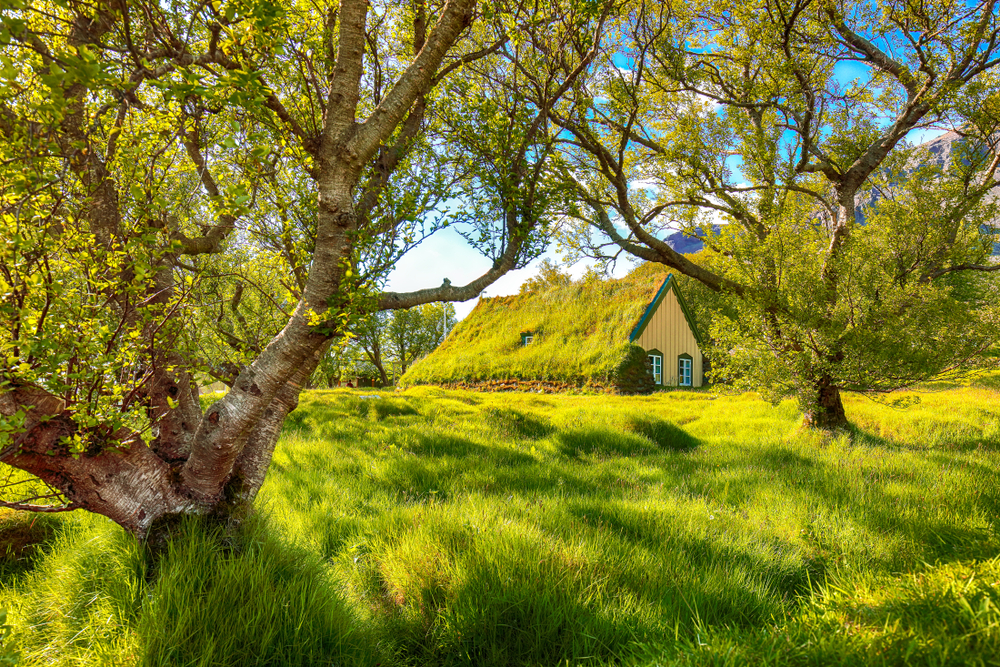
Stop 28: Marvel At The Imposing Lomagnupur Mountain, Home Of A Giant
Lomagnupur Mountain is left off of many tourist itineraries, and without a designated parking lot or clear indicating signs, it is often passed by as you race onward towards waterfalls and dramatic canyons. And yet this captivating mountain that towers almost 700 meters high, dominates the landscape.
It is visible from far away as you drive closer and upon reaching the mountain you’ll find it imposing as it dwarfs you in size. If you have the time on your trip to take a moment to appreciate this fantastic beast of a mountain, we highly suggest you do so.
The area surrounding the mountain enhances its beauty with water that reflects its image, black sand and pebbles framing its base and volcanoes and glaciers making up the greater landscape. Lompagnupur is known for having a history of landslides, the results of which can be seen etched into the mountainside like scars.
The mountain also holds a place in the Icelandic Saga, Njáls, and is believed to be home to a giant. Particularly on a clear day, it’s almost impossible not to capture a stunning photograph of this side of the road goliath.
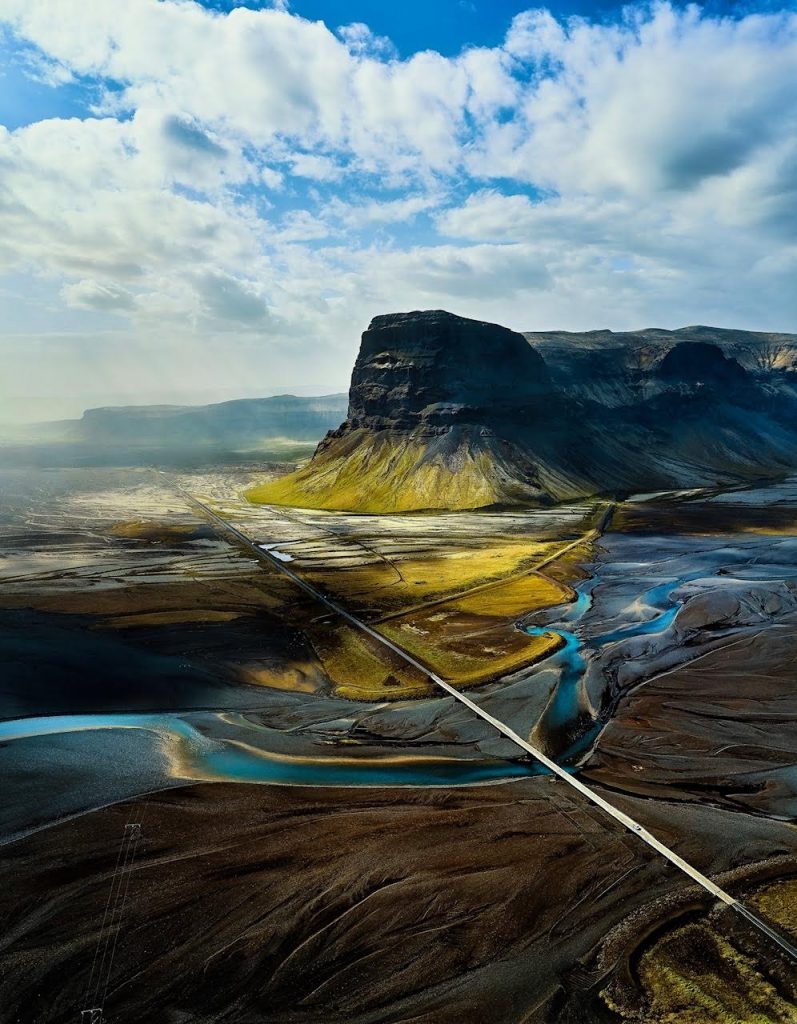
Stop 29: Watch Svartifoss Waterfall Stream Down In Front Of Basalt Columns
All of Iceland’s waterfalls are unique and the 65-foot Svartifoss waterfall, located in the Skaftafell National Park, is no exception. This is also a huge stop on our 5 days in Iceland itinerary!
It’s not one of Iceland’s most impressive waterfalls in terms of size, but backed by black, organ pipe-like hexagonal basalt columns, the site of this glacier-fed waterfall is spectacular. The contrast of the black backdrop against the flowing water makes the waterfall and surrounding glaciers really stand out.
While you’re there be sure to pay attention to signs and fenced off areas. The vegetation is fragile and needs to be preserved or in some cases revived, so let it thrive and stick to the path.
From the visitor’s center you’ll hike about 3.5 miles round trip through the campground and back around in a circle. As with most hikes in Iceland, it’s equally about the journey as it is the destination.
You’ll pass two other waterfalls on your way to Svartifoss, Hundafoss, and Magnusarfoss, and on your way back you’ll pass the Selið turf house farm for a glimpse into Iceland’s Settlement days.
If you’re visiting in the winter you’ll likely find these stunning waterfalls sparkling with ice and snow. Be sure to wear crampons to make the trek to the waterfall safer and easier to navigate.

Stop 30: Hike Past Multiple Waterfalls To Mulagljufur Canyon
Mulagljufur Canyon is one of Iceland’s lesser-known canyons along the South Coast, but it is certainly a gem. Once you reach the gravel parking area you’ll hike along a moderately difficult trail for roughly 1.5 miles to reach the canyon.
Wear sturdy, waterproof hiking boots. You will get wet crossing rivers and squelching through mud, but the views are more than worth it. Trekking to Mulagljufur is the perfect way to leave the South Coast crowds behind and marvel at the beauty that nature has created.
Though steep canyon walls and flowing rivers would be enough to draw anyone in, this canyon also offers a look at two beautiful waterfalls, Hangandifoss and Mulafoss. At 50m, Mulafoss is perhaps not the most impressive of the waterfalls you’ll experience along the South Coast, but it carries its own beauty streaming from the canyon walls.
Hangandifoss, on the other hand, is quite tall at 123m, and paired with the imposing canyon walls it would surely be a well-trafficked South Coast staple if it were more easily accessible and clearly marked. For now, be thankful it is neither as you’ll feel particularly special getting to appreciate the magnificence of the waterfall all on your own.
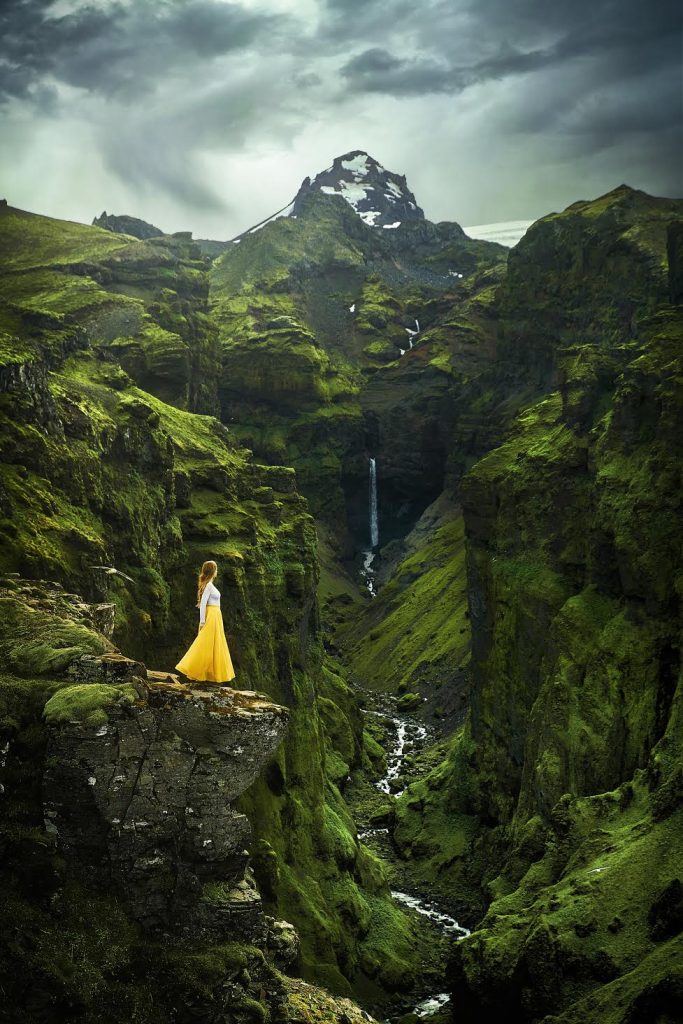
Stop 31: Enjoy The Peace And Quiet Of The Smaller Fjallsarlon Glacier Lagoon
Though Fjallsarlon is smaller and less frequented than its neighbor Jokulsarlon, these are exactly the reasons that this glacier lagoon is magical. The lagoon is on the south end of the Vatnajökull glacier (Europe’s biggest glacier outside of the Arctic). You’re unlikely to find the big tour buses here, meaning you’re free to absorb your natural surroundings in relative peace and quiet.
In the silence you might hear the ice breaking and colliding as the scene slowly but constantly continues to shift. Though there’s still a lagoon separating you from the glacier, at Fjallsarlon your experience with the majestic, calving glacier is far more intimate.
Fjallsarlon is conveniently located right off the Iceland Ring Road just before you reach Jokulsarlon. Once you park, you’ll walk a short distance to reach the edge of the water and be face to face with sparkling icebergs.
Because Fjallsarlon is smaller in size, you might find that standing on the shore and taking in the views is enough to give you a complete experience at the lagoon. If however you wish to get even closer, you can take a boat tour allowing you to navigate through the icebergs on a small boat with a knowledgeable guide.
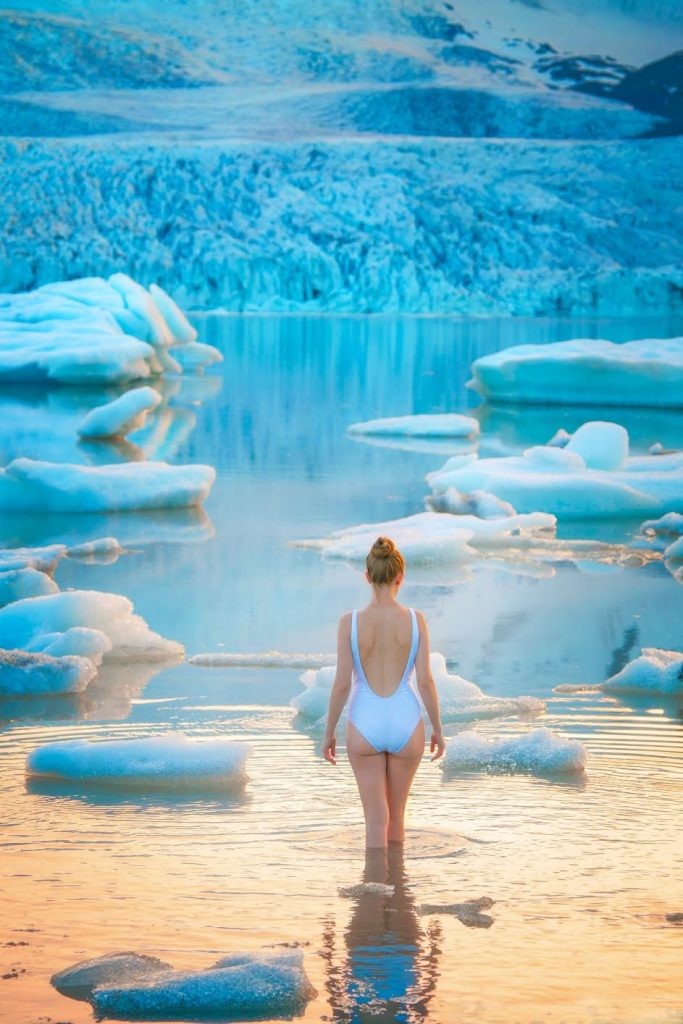
Stop 32: Watch The Beautiful Floating Icebergs At Jokulsarlon and Diamond Beach
Next up on your Iceland Ring Road itinerary is the Jokulsarlon Glacier Lagoon, Fjallsarlon’s much larger neighbor. Located on the east part of the South Coast, Jokulsarlon is a stunning lagoon filled with floating icebergs. The lagoon is ever-changing as the surrounding glacier continues to melt and new ice blocks fall.
During the summer, you can take a boat tour through the lagoon and get an up-close view of the icebergs. All year long you can view the lagoon from the shore, walking along its edge to see the icebergs from varying angles. The enormous glacier looms large in the background.
Across the street is a black sand beach called Diamond Beach. It sets itself apart from other black sand beaches like Reynisfjara Beach because the entire beach is covered in clear sparkling ice. Pieces of the icebergs floating in the glacier lagoon break off and wash ashore, scattering themselves around the beach.
The contrast of the black sand against the clear ice is striking and makes for some powerful photographs. The beach becomes even more fairytale-esque at sunset when the sky is painted yellow.
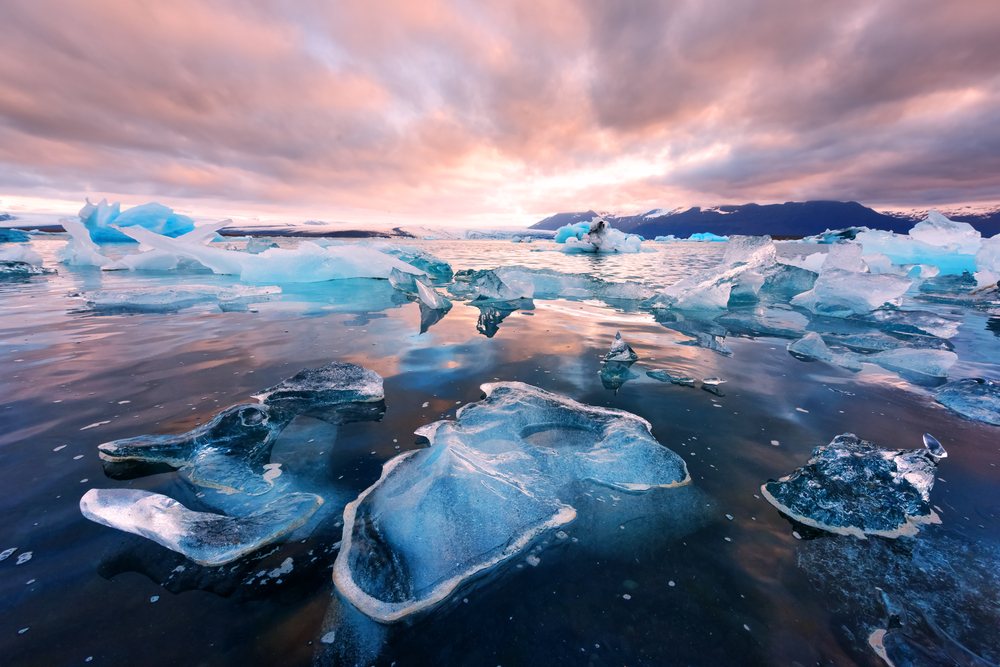
Where To Stay In Southeast Iceland:
Mid-range: Skyrhúsid Guest House. Check rates: Booking.com
Mid-range/Luxury: Hotel Skaftafell. Check rates: Booking.com
Best Iceland Ring Road Stops In The East
Stop 33: Capture Vestrahorn’s Striking Reflection In The Water
Vestrahorn is one of the country’s most striking mountains. Think jagged, snow-capped mountains seemingly rising from the edge of the Atlantic Ocean surrounded by dunes of pitch-black sand spotted with tufts of brilliant green seagrass. When the purple lupines are in bloom the scene is even more fantastic.
When a thin layer of water covers the beach, you can see the reflection of the mountain and yourself as you appear to be walking on water. Be careful though as you photograph from the beach as the waves can sneak up on you if you’re not careful and they have the potential to be high and strong.
The mountain itself is called Vestrahorn (nicknamed “Batman Mountain”) and is located on the Stokksnes Peninsula. Typing in Vestrahorn Mountain into your GPS will take you to the exact location.
When you reach the Viking Café you’ll have to pay the 800 ISK entrance fee. The fee is well worth the sites you’ll see.
This is the perfect spot to catch a dramatic sunrise or sunset as the brilliant colors light up the mountain. It’s also a great spot for Northern Lights viewing given the right weather conditions because the sky is so dark out at the beach.
If you want to stay nearby, you will want to stay in the town of Hofn! Here are the Best Hotels And Hostels In Hofn!
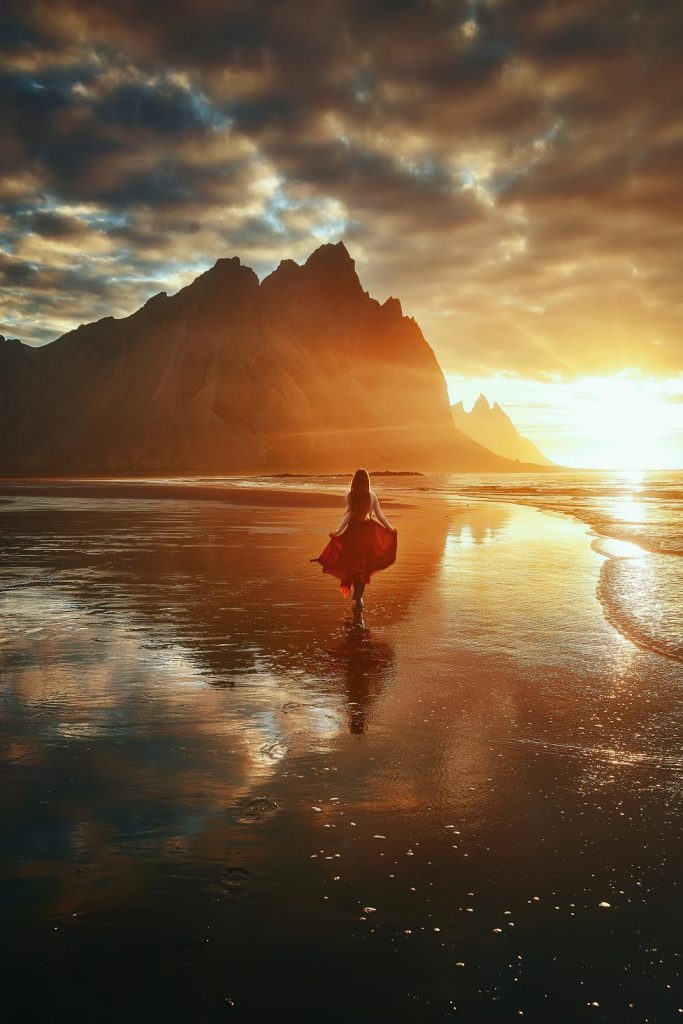
Stop 34: Walk Through A Viking Village Film Set Next To Vestrahorn
The 800 ISK you’ll pay at the Viking Café will not only allow you to see Vestrahorn, it also gives you access to the abandoned Viking village movie set right next door. A short, easy walk will take you to the village, and you’ll likely spot some sheep and Icelandic horses along the way. The village was constructed back in 2010 for an Icelandic movie that never came to fruition.
Until the day it becomes a film location, it remains a tourist attraction for those eager to see an impressive replica of a Viking village. It’s time to let out your inner Viking!
The village is small and clearly weathered by the elements over the years, but its construction is fascinating none-the-less. You’re free to wander through the set as you wish, exploring at your own pace. With its proximity to the beautiful beach and the striking Vestrahorn Mountain, the Viking village makes for the perfect stop while you’re in the area.
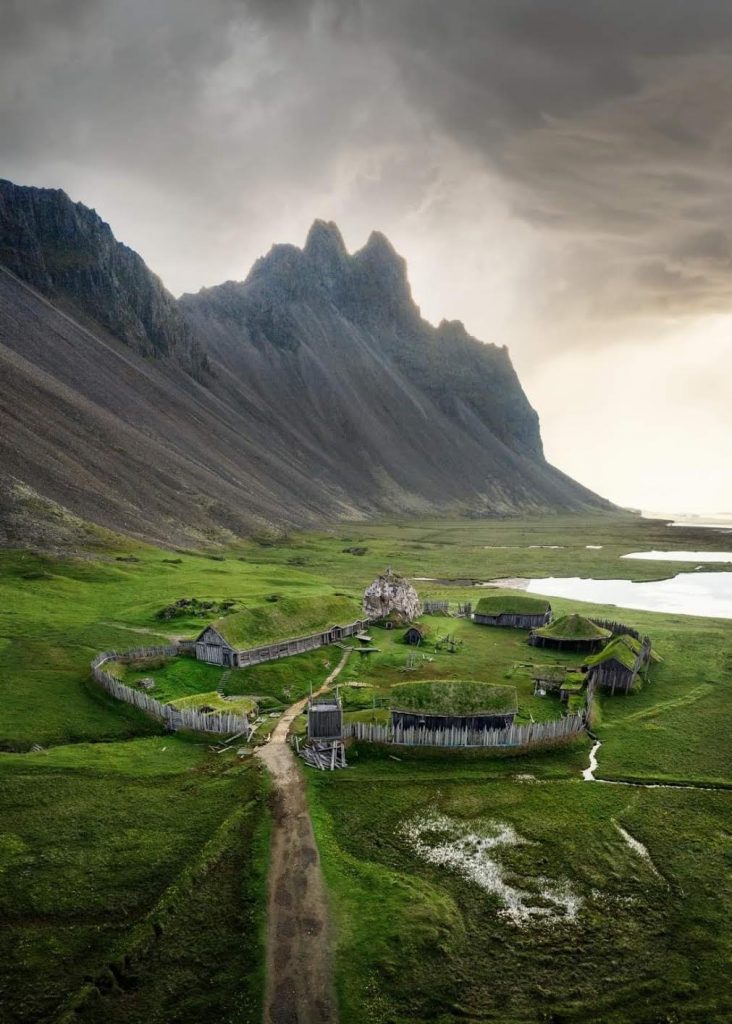
Stop 35: Wonder At The Unusual Red Chair Art Installation In A Mossy Landscape
We’re throwing you a curveball with this next stop on your Iceland Ring Road itinerary. In the middle of your visits to thundering waterfalls, jagged mountains, and black sand beaches, we’re sending you to a red chair art installation seemingly in the middle of nowhere.
Between Hofn and Egilsstadir where the landscape becomes sparser, you’ll happen upon a large red chair, bolted to a raised pile of rock, breaking up the vast mossy expanse. It can be an interesting and unusual spot for photographs or just a surprise in an otherwise monotonous section of the Ring Road drive. Its existence is bizarre and intriguing and might just make you smile.
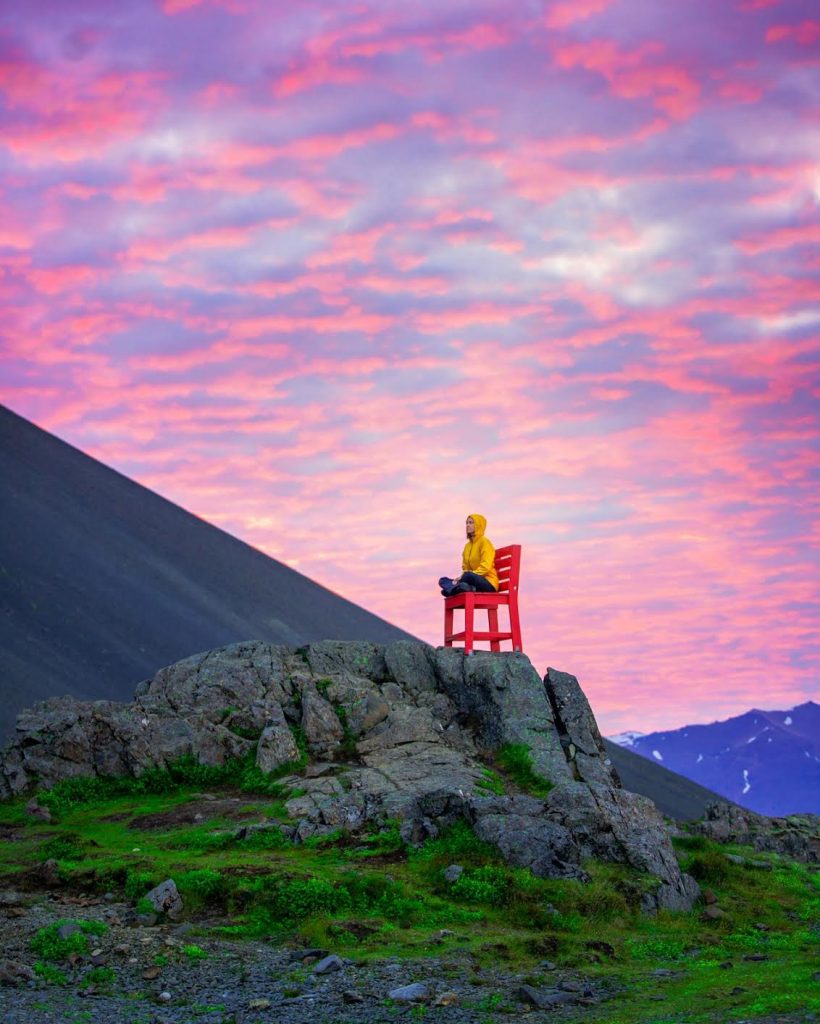
Stop 36: Take In The Views From The Base Of The Bright Orange Hvalnes Lighthouse
The Hvalnes Lighthouse is distinctive and easily visible due to its unusual, bright-orange, concrete exterior. It has been in operation from 1955 to the present, standing guard (at 38 feet high) over the Hvalnes Nature Reserve. The area boasts some impressive scenery including black sand beaches and the spiked Eystrahorn Mountain that bares a striking resemblance to Vestrahorn.
The lighthouse itself only requires a brief stop to walk up to its base from the parking lot. You can’t explore inside the lighthouse, but its vibrant color paired with the spectacular views of Iceland’s wild nature is what really draws in visitors and their cameras.
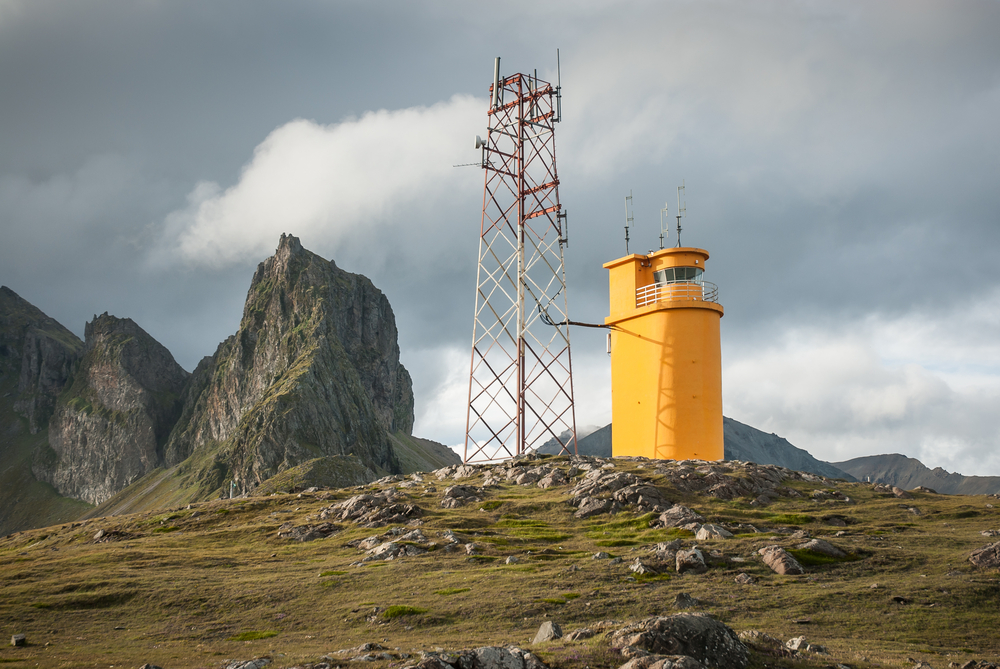
Stop 37: Spot The Unusual Rock Formation Along The Laekjavik Coast
The Laekjavik Coast refers to a section of black sand beach located between Hofn and Djupivogur with a unique rectangular rock formation protruding out of the ocean. The East Fjords have plenty of their own sweeping, stunning views and this is certainly one of them.
Though the Laekjavik Coast is visible from the Iceland Ring Road it’s not one of the more frequented spots so you’re likely to have a quiet, tranquil experience walking its length. Take a short break from your long drive and walk the beach soaking in the views and the power of the Atlantic Ocean.

Stop 38: Hike To Hengifoss and Litlanesfoss To Experience Two Spectacular Waterfalls
Hengifoss is an extraordinary waterfall thundering down from 420 feet high making it the 3rd highest waterfall in Iceland. It takes some effort to reach, but boy are you rewarded in the end.
The hike to Hengifoss is just over 3 miles round trip of moderately difficult trekking with some steeper parts along the way. The good news is you’ve just embarked on a hike that’ll give you two for the price of one. We’re talking about the spectacular Litlanesfoss Waterfall you’ll encounter 1.3 miles into your trip.
Like Svartifoss and Aldeyjarfoss, this beauty is surrounded by basalt columns. Litlanesfoss falls in two sections curving around a corner to escape through the gap in the columns. It is truly breathtaking and that’s not even the pièce de résistance.
As you continue your hike you’ll eventually spot Hengifoss, though the trail does not end there. Continue along it for a more up close view at the towering waterfall. As you approach the waterfall you’ll notice the black basalt intermingled with strips of red clay creating a very unique backdrop to the waterfall.
The entire hike is enjoyable, and the two uniquely wonderful waterfalls make it all the more rewarding. Make sure you give yourself plenty of time to complete the full hike so you can walk away having seen and appreciated both waterfalls.

Stop 39: Admire The Basalt Columns And Blue Water Of Studlagil canyon
Visiting Studlagil Canyon you can’t help but feel lucky that you’re one of the people getting to view this exceptionally beautiful piece of nature that only recently surfaced, literally. Studlagil is a newer wonder of Iceland due to the fact that the Jokla glacial river raged through the canyon keeping its stunning basalt column formations underwater.
However, the construction of the hydroelectric plant Karahnjukavirkjun changed the course of the river and what was left in the Jokuldalur valley was nothing more than a tame stream. Though it’s sad to think of the natural course of nature being affected, visitors to this remarkable spot have been granted the wonderful ability to see this basalt canyon in its full glory. The structures of these basalt columns are like a piece of artwork and their black and orange coloring are an ideal contrast to the vibrantly blue water.
You have two choices when visiting the canyon. The first is to park at the Grund farm on the west side of the canyon and walk a short distance to view the natural beauty. If you wish to make a hike out of your visit, walk down to the river’s edge, or see the Studlafoss waterfall, the east side is definitely the way to go.

Stop 40: Warm Yourself Up In The Small Djupavogskorin Hot Spring
Visiting Iceland you become spoiled for choice with hot spring options giving you the unique opportunity to bathe in geothermal water in the middle of nature. The Djupavogskorin hot spring is one of these fantastic options. Just off the Iceland Ring Road you’ll find this hot spring out of sight of the actual road with a small parking lot.
Roughly the size of two bathtubs, this small hot spring is one you’ll likely enjoy all by yourself in peace and solitude. There’s not much to it with just the small tub and a few wood pallets to step on to as you get in the tub, but sitting there in the middle of nature with wonderful views of the Atlantic Ocean, you can’t help but relax and feel happy.
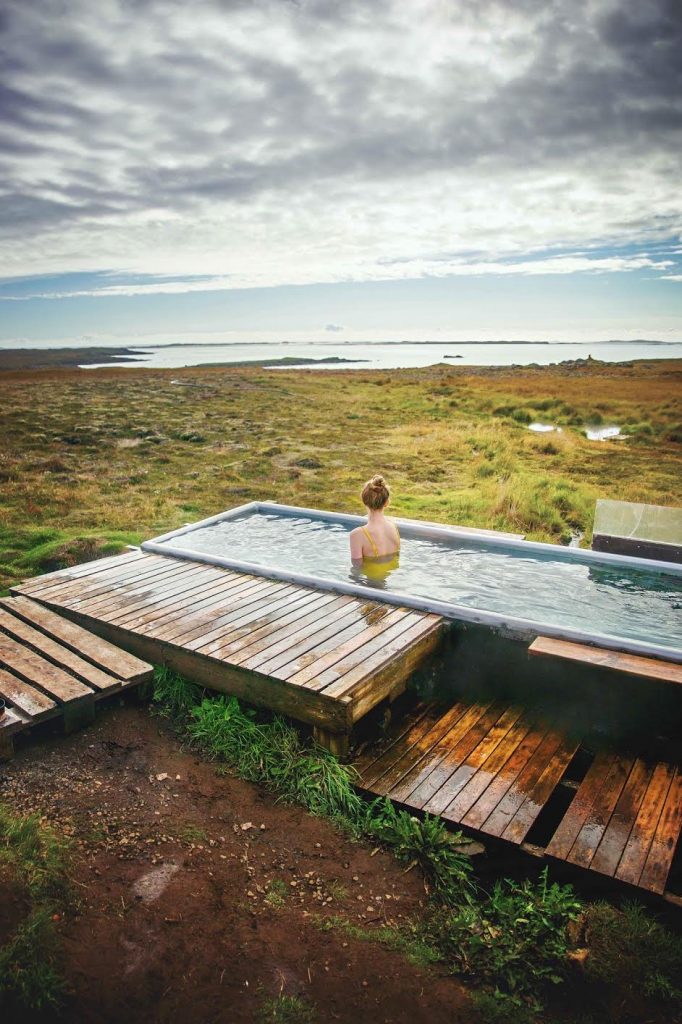
Stop 41: Walk The Rainbow Street To The Blue Church In Seydisfjordur
Of all Iceland’s small towns, Seydisfjordur holds the most charm. It is a community of artists inspired by their town and the natural surroundings.
They have created a town full of color, with colorful Norwegian style buildings, unique garden sculptures, and a signature rainbow pathway that leads up to the distinctive blue church. The town may be small, but it is vibrant in every sense of the word and you can’t help but have a good time while you’re there.
Though drinking a coffee or enjoying an authentic Icelandic meal on the main street while people watching and admiring the colors of the town is a perfectly great way to spend your time, there’s also plenty of other ways to enjoy yourself including visiting the blue church and taking strolls or hikes to take in the natural beauty of the area. The town is on a fjord after all, which gives it a wonderful natural harbor and excellent views of the water and the surrounding mountains.
There are also museums, a public swimming pool (as there is in every Icelandic town) and a thrilling summer arts festival in July. It’s remarkable that such a small town can offer so much.
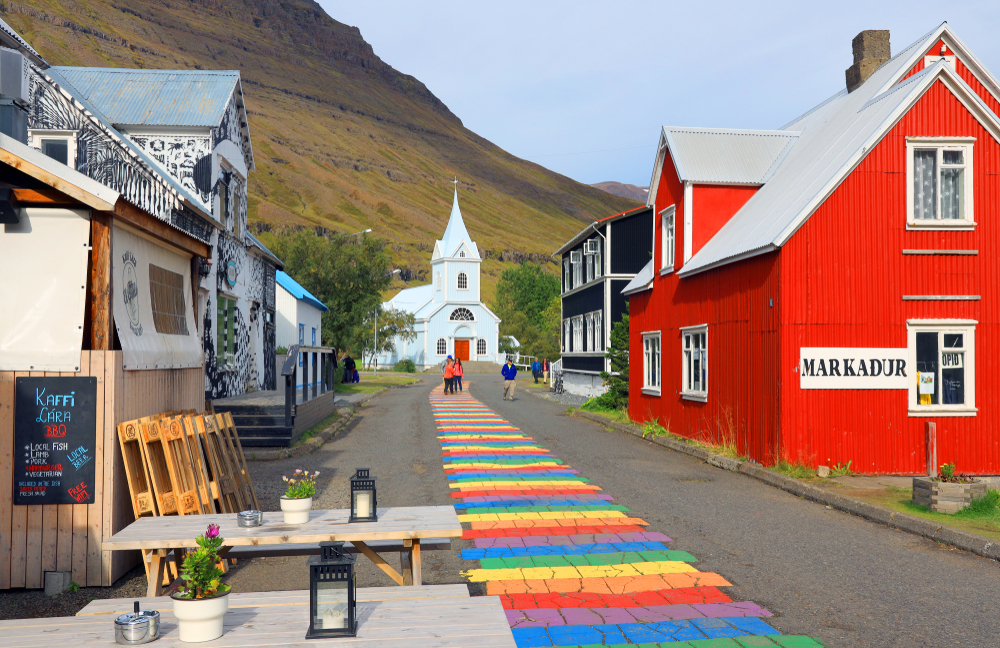
Where To Stay In East Iceland:
Affordable: Blabjorg Guesthouse. Check rates: Booking.com
Mid-range: Fosshotel Eastfjords. Check rates: Booking.com
Mid-range: Glacier World-Hoffell Guesthouse. Check rates: Booking.com
Best Iceland Ring Road Stops In The North
Stop 42: Find Yourself Dwarfed By Dettifoss And Captivated By Selfoss
You have not seen true power until you’ve stood beside Dettifoss Waterfall and watched the sheer force of the thundering glacier water plunging over the edge. The Jökulsá á Fjöllum River is responsible for feeding this beast. As you stand there, feeling particularly small beside this giant, you understand why it is has been deemed the most powerful waterfall in Europe.
It’s possible to reach Dettifoss from both the west and the east side, though you’ll find yourself at entirely different viewpoints depending on which you choose. We suggest choosing one, as the two parking lots are an hour apart and driving to both will eat up a considerable chunk of your day.
Both sides have spectacular views of the waterfall, though you can get closer from the east side. In either case, you’ll walk a relatively short distance following a path from the parking lot to see the waterfall.
Just half a mile walking from Dettifoss you’ll find the beautiful cascading waterfall Selfoss. It certainly contains nowhere near the power or size of its neighbor, but it is striking none-the-less as it falls gracefully in sections over a wide length of the canyon. It’s worth your time and the extra walking before returning to the main parking lot.
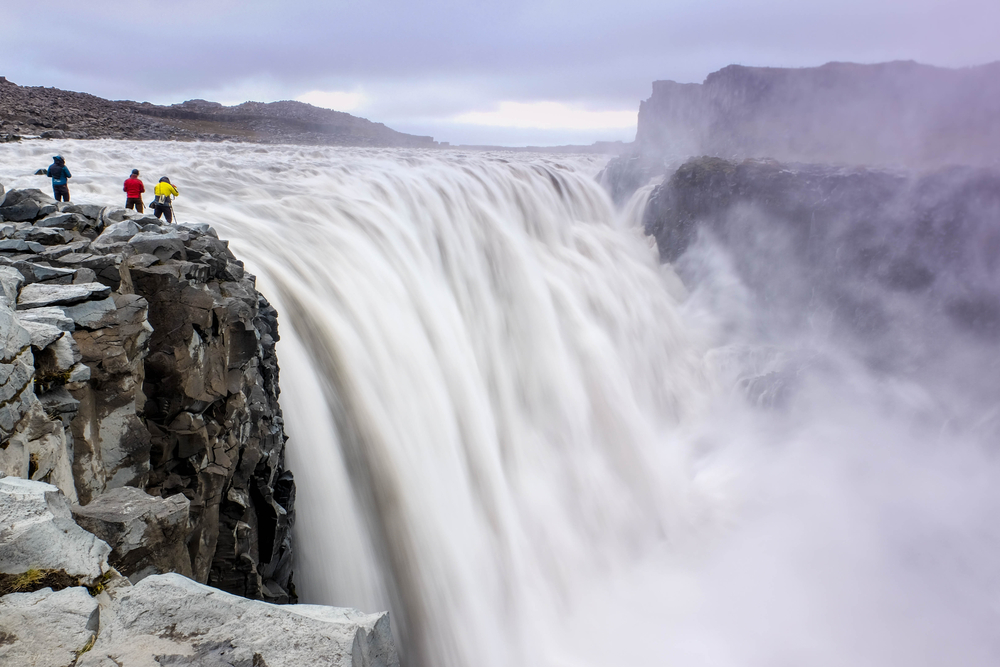
Stop 43: Walk The Rim Of The Famous Viti Crater In The Krafla Volcanic Region
An eruption in the Krafla volcanic region produced the well-known Viti Crater. The best way to explore this mesmerizing crater is by walking along the rim. You’ll have to walk for roughly 20 minutes first to reach the rim.
Be aware the rim path is intermittently closed off for restoration purposes so you may be limited to viewing the crater from one viewpoint which still gives you a relatively full picture of the beauty of the area, and may actually be the ideal option if you’re pressed for time. The center of the crater is filled with brilliant blue lake water in stark contrast to the brown and orange tones of the surrounding mountains.
As you walk along the rim you’ll find a second much smaller lake to the side as well as a small, steamy geothermal area with bubbling mud and of course the otherworldly vast expanses of lava fields. The whole area is like something from another planet. The landscape is truly captivating.
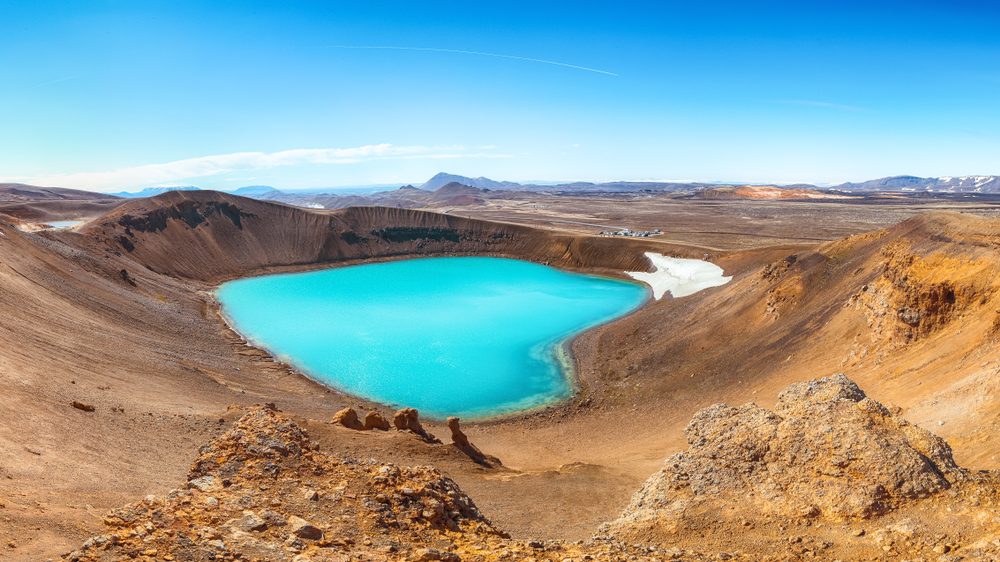
Stop 44: Relax At The Myvatn Nature Baths, The Blue Lagoon Of The North
The Myvatn Nature Baths is the northern counterpart to the Blue Lagoon. A relaxing, geothermal wonderland of the bluest warm water, welcoming you in from the harsh Icelandic cold. Though still pricey, it’s less expensive and less crowded than the Blue Lagoon, though the nature baths continue to rise in popularity at an exponential rate.
Like the Blue Lagoon, the minerals in the water have healing qualities, and the ideal water temperatures which hover between 36 and 40°C mean you can spend hours enjoying the warmth and serenity of the baths and their surrounding landscape. The complex also has two wonderful steam baths for your enjoyment.
When visiting the nature baths, be sure to leave jewelry at home or in the changing room or it will get damaged from the sulfur in the water. There’s also a mild sulfur smell, but it’s nothing offensive.
The Myvatn Nature Baths are the perfect stop at any time of year as the chilly Icelandic temperatures even in summer make the warm water particularly inviting. If you visit in the winter close to closing time, you might even be fortunate enough to catch a glimpse of the Northern Lights on a clear sky evening.
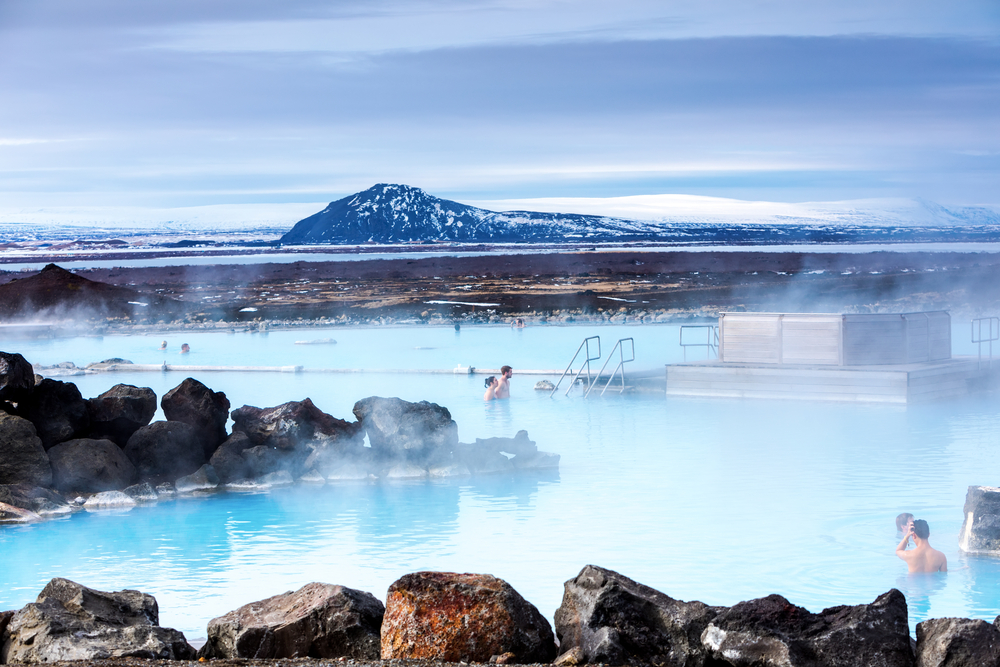
Stop 45: Climb Down Into The Grjotagja Cave For Looks At The Stunning Blue Pool
Game of Thrones fans brace yourself because you’re headed to the famous lava cave and hot springs where the iconic love scene between Jon Snow and Ygritte occurred in Season Three. If you’re not a Game of Thrones fan, you will absolutely love this location too, because as you descend through the narrow opening into the cave, you’ll find that the stunning blue pool inside is nothing short of magical. Unfortunately, it’s no longer possible to swim in the natural pool.
Though its temperatures were once perfect for bathing, volcanic activity caused a surge in the water temperature. The water temperature continues to fluctuate, but continues to remain unsafe. Please don’t try to touch the water.
You can capture wonderful pictures of this underground beauty from the rocks alongside the water. This will likely be a short stop as there’s not much room down in the cave.
It has the potential to become crowded with tourists, and you might have to wait in a line to enter the cave. For smaller crowds you might want to consider visiting early in the morning.
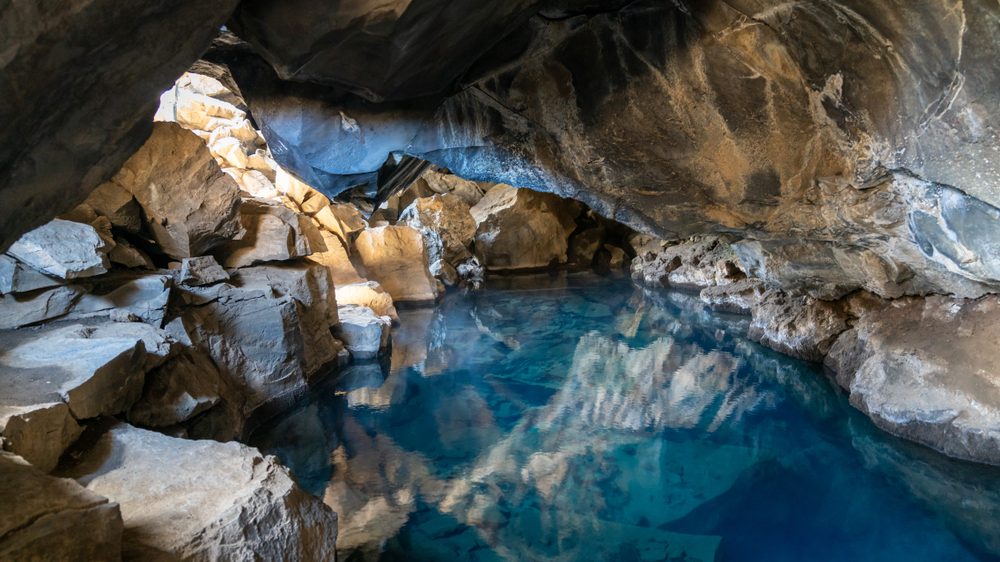
Stop 46: Sit And Marvel In The Majestic, Smooth Beauty Of Godafoss Waterfall
Godafoss Waterfall is one of Iceland’s best. It translates to Waterfall of the Gods, referring to when the law speaker Þorgeir Þorkelsson threw his idols of the old Norse Gods into the waterfall when Iceland officially converted to Christianity. Godafoss stretches before you in a half-circle, split roughly down the middle to form two sections of silky, flowing water, with a third thin sliver flowing straight down the middle.
The majestic fall creates a brilliant green-blue pool at its base. There are plenty of spots to view the waterfall on either side. Because it spans such a wide distance it’s hard not to get an exceptional viewing angle.
If you want to walk down to the edge of the pool created by the waterfall, we suggest viewing it from the east side. The café/gift shop is also located on this side. If you’re not intent on walking down to the water, we suggest staking out a nice, dry spot along the edge on the west side and just enjoying the views.
When the weather behaves, it’s easy to spend a considerable amount of time here. As you walk along the edge, be careful of the water puddles and slippery water-coated sections. Though you’ll have to take extra care when visiting in the winter, the waterfall is equally stunning any time of the year.
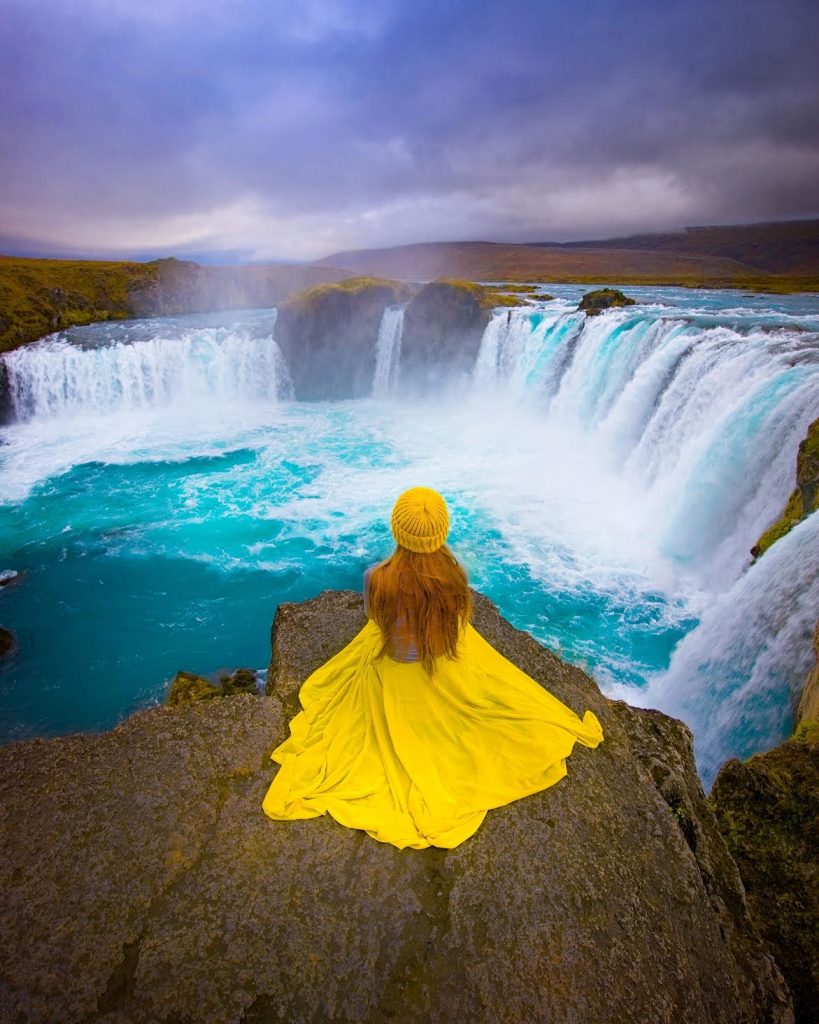
Stop 47: Drive Up To Aldeyjarfoss Located Remotely In The Highlands
It wouldn’t be Iceland without more basalt columns and awe-inspiring waterfalls. So we bring you Aldeyjarfoss. Located up in the highlands in a more remote location, you’re bound to find yourself relatively alone in this remarkable landscape.
Though it’s only a 65.5 foot drop, the waterfall looks like it has broken through a sturdy basalt wall, powering through its center with a cave-like structure on one side. It shares a lot of qualities with the Svartifoss Waterfall, but it’s unique enough and plenty beautiful to deserve its own separate visit.
The waterfall is fed by the Vatnajokull Glacier (Europe’s largest glacier) and the Skalfandsfljot River which also feeds Godafoss. It flows into a large basin. There are a couple of other “pools” in front of the waterfall that look similar to many of Iceland’s natural hot pots, but these pools are in reality very cold.
In the summer, it’s actually possible to drive all the way up to the waterfall, but in winter you’ll need to park and walk the remaining 40 minutes or so. You’ll want to rent a 4×4 vehicle because the last part of the drive turns into a narrow gravel road (F-26).

Stop 48: Look For Whales In Husavik, The Whale Capital of Iceland
If you have any interest in whale watching, Husavik is the place to be. Though other places in Iceland offer whale-watching tours, such as in Akureyri, there’s no better place to spot these gentle giants than Husavik.
There are a number of whale watching companies in the town, one of which is North Sailing who are particularly attentive about making sure you have a great experience while keeping an appropriate distance so as not to sacrifice the whale’s well being in the process. There are a number of different tour options including one that also takes you out to Puffin Island to see the funky, adorable looking birds.
After a day at sea, there’s no greater way to relax than at the Geosea Spa. The geothermal sea water-filled baths hover just over the ocean itself in somewhat of an infinity pool style.
As you soak in the healing, mineral-rich water you’ll likely spot many of the whale watching boats. If you’re lucky you might even glimpse a whale yourself.
You’re free to spend as much time here as you wish enjoying the warmth and beautiful natural surroundings. The Geosea Spa is becoming increasingly popular and a limited number of guests are allowed in the water at one time, so you might want to consider booking a time slot in advance to ensure you get to enjoy the serenity of the unique bathing experience.

Stop 49: Explore Akureyri, The Capital Of The North
Akureyri is the biggest town outside of Reykjavik and is often considered to be the capital of the North. As a result there’s no shortage of things to do and see during your visit.
Perhaps the most well known landmark is Akureyrarkirkja, the church located roughly in the center of the city. Visitors are welcome inside the church and it’s a wonderful spot for photographs particularly ones that include the long staircase leading up to its doors.
In the summer, we suggest visiting the beautiful and well-kept Akureyri Botanical Garden. If you visit in the winter, or are just looking to get in the Christmas spirit, Akureyri is home to the Christmas House that is open all year long! It will have you singing Christmas songs and longing for the days of gingerbread house building and tree decorating in no time.
Icelanders also love their ice cream at all times of year so naturally there’s a famously delicious ice cream shop in town called Brynjuís. To warm up after the ice cream you might head to the public swimming pool to hit the hot tubs.
There are also a number of interesting museums including the Akureyri Art Museum and The Aviation Museum. As a major town, stopping in Akureyri also gives you the chance to stock up on groceries and gas. You can spend the night at one of the many Akureyri Hotels, Iceland’s second-largest city!
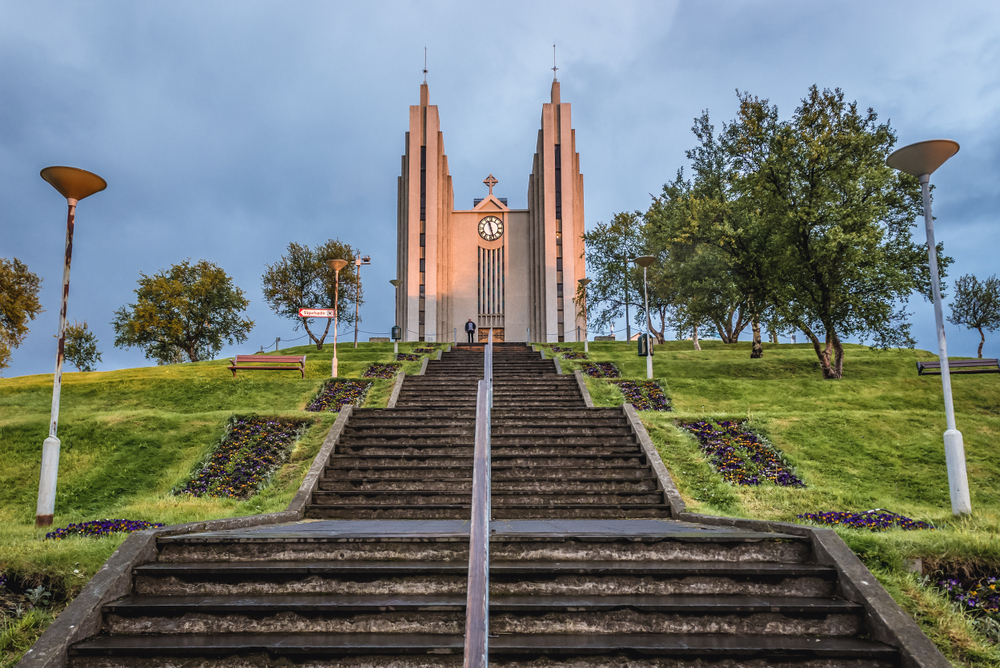
Stop 50: Swim In The Infinity Pool In The Town Of Hofsos
Hofsos was once a trading port, but today there’s not much happening in this small fishing town. And yet this little village has made it on to our itinerary anyway.
Why? Because the idyllic swimming pool alone is reason enough to give the town an hour or two of your time. The swimming pool in Hofsos is essentially an infinity pool disappearing into the ocean and successfully blending land and sea.
Technically there is land separating the pool from the ocean, but the general effect of an infinity pool is still achieved. Swimming in this pool allows you to bask in the glory of your natural surroundings from the comfort of a heated pool. For a little more warmth there’s a hot tub as well.
If you’re visiting Hofsos in the summer, it’s also worth spending some time at the old building that houses the Iceland Emigration Centre where you can learn about Icelanders emigrating to North America in the late 1800’s.

Stop 51: Walk Down To Hvitserkur, The Monolith Rising From The Sea
Iceland has the usual ability to make you fall in love with rock formations. Hvitserkur is one of them.
This impressive 49-foot monolith rising from the sea is thought to resemble many different things including a rhino, elephant, and dragon that appears to have its head down drinking. Story has it that Hvitsekur was actually an evil troll on a mission to destroy the annoying bells at a nearby church and was turned to stone as first light hit in the morning.
Hvitserkur translates to “white shirt” a name that is thought to come from the white bird droppings covering it courtesy of the nesting birds. Over time the rock structure continued to erode creating the image you see today. It is largely natural, however the bottom is reinforced with concrete to fortify the structure.
After parking, you can choose to remain up above for an easy, distant view of Hvitserkur or you can follow the path down to the beach for an up close look. At low tide you can walk right up to the rock.
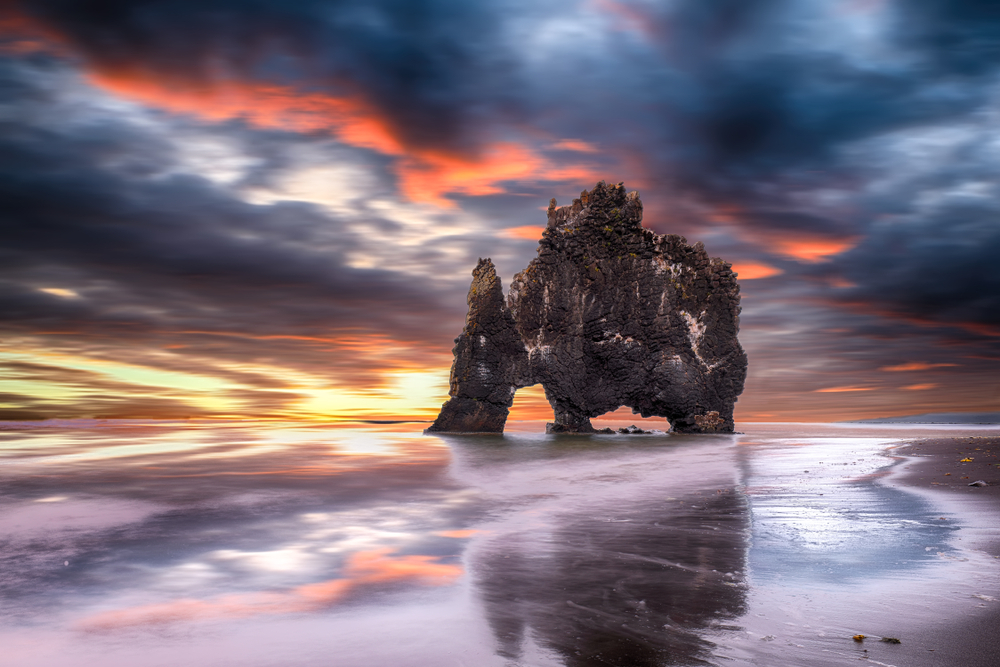
Where To Stay In North Iceland:
Affordable: Icelandair Hotel Akureyri. Check rate: Booking.com
Mid-range: Hotel Laxa. Check rates: Booking.com
Luxury: Siglo Hotel. Check rates: Booking.com
Best Iceland Ring Road Stops In The West
Stop 52: Take A Separate Trip To the Spectacular Westfjords
The Westfjords are not on the Iceland Ring Road, but we included it in our itinerary should you decide to include it as its own separate trip. Driving the Westfjords is absolutely spectacular.
The calm remoteness of the fjords is breathtaking and calming, not to mention there seems to be a trickling waterfall at every turn. Besides its general beauty, the Westfjords is home to its own list of spectacularly unique attractions, which are usually less frequented as fewer tourists venture to the Westfjords.
There are a handful of attractions we’d like to draw your attention to starting with Dynjandi a cascading, lacy waterfall. It is broad and beautiful and is sure to captivate your attention.
You might also be interested in the Raudasandur Beach, a spectacular beach unique for its striking red colored sand. Iceland is famous for its black sand beaches, but Raudasandur is equally unusual.
If you’re hoping to catch a glimpse of the adorable puffins, you’ll likely find them at the Latrabjarg Cliffs, a set of windy cliffs marking the westernmost point in Iceland. And finally for a relaxing soak with ocean views we suggest heading to the Drangsnes Hot Pots, a collection of 3 different natural hot pots of differing temperatures.
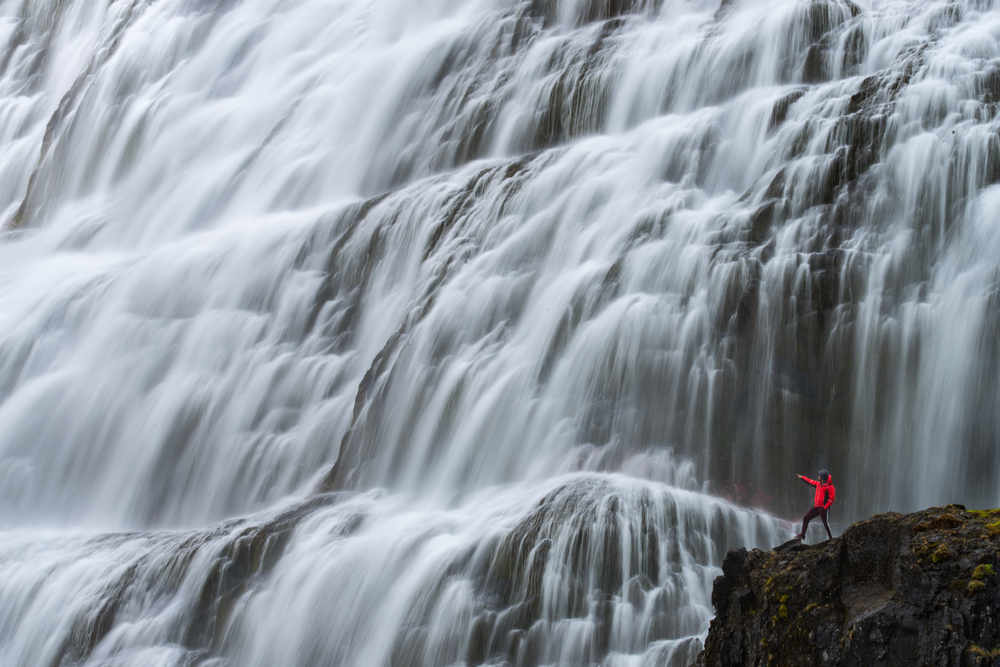
Stop 53: Photograph The Iconic Kirkjufell Mountain and Kirkjufellsfoss Waterfall
Kirkjufell (Church Mountain) is another one of Iceland’s iconic landmarks that you’ll likely have seen on a postcard or two in the tourist shops. You might also recognize it as Arrowhead Mountain from the Game of Thrones TV show. This cone-shaped mountain is easily recognizable.
Kirkjufell is a bit of a detour from the Iceland Ring road and is located on the Snaefellsnes Peninsula near the town of Grundarfjordur. Though it’s possible to complete the strenuous hike to the top with a guide, the majority of visitors stick to walking around the base instead before wandering over to the picturesque Kirkjufellsfoss Waterfall. Kirkjufellsfoss is a beautiful three-tiered waterfall with the perfect view of Kirkjufell in the background.
Kirkjufell and Kirkjufellsfoss can be visited at any time of year. In fact, we urge you to return and visit it multiple times of the year.
In the summer, the mountain is covered in striking green and the water of the falls flows freely. In the winter, the mountain and surrounding area are often covered in a layer of white with icicles breaking up the steady flow of the waterfall.
It’s easy to see why this is the most photographed mountain in Iceland. So whip out your camera and get your own unique shot of this well-known beauty.
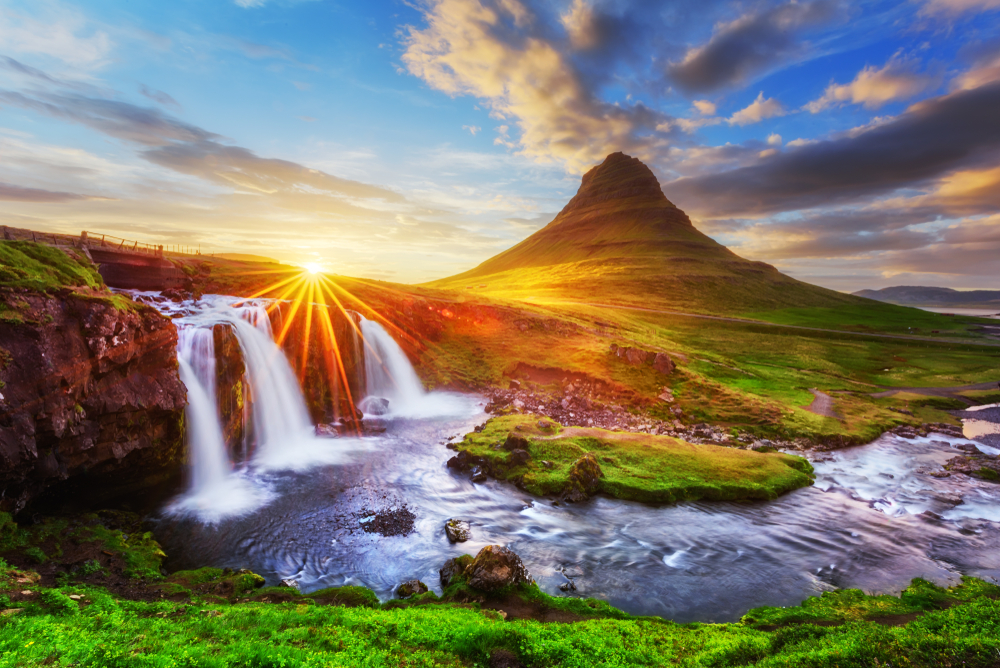
Stop 54: View The Two Pillars Of Londrangar From Up Close Or Far Away
The pillars that make up Londrangar are what remains of two volcanic plugs. They are incredibly unique in shape.
From certain angles, they combine to almost look like a ship with its sail up emerging from the water. It’s a striking image and makes you marvel at the creations nature comes up with.
It’s possible to walk up to the pillars starting at the lighthouse at Malarrif and get an idea of their true size, however, the image is almost more picturesque viewing it from afar where you can take in its full shape and surroundings. If you do choose to walk closer, pay attention to the waves as they can be powerful and dangerous.
Londrangar is also home to many sea birds including the puffin. Take a walk along the coast (be prepared for it to be very windy), and soak up the views and fresh sea air. Between the crashing waves and the pillars of Londrangar, you get a real sense of the impressive power and force of nature.
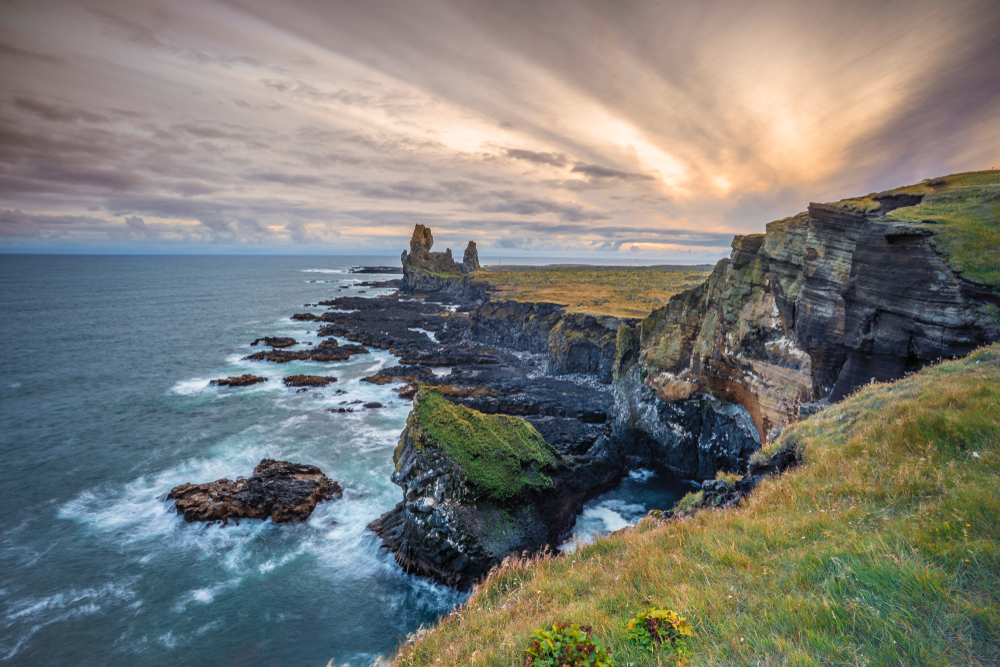
Stop 55: Walk Along A Natural Bridge At Arnarstapi
Arnarstapi is a small village on the Snaefellsnes Peninsula and was once a thriving spot along the harbor for fishing and trading. Today, the village itself is pleasant and charming and you might be interested in grabbing some fish and chips at the summer food truck on your way out, but the nature surrounding the town is the real reason you’ll want to stop here.
There are a number of iconic spots that are typically photographed when visiting Arnarstapi. These include the little white house backed by the pointy Mt. Stapafell, the arched rock referred to as Gatklettur, and the stone statue of Bárður Snaefellsás, the half-troll/half man who settled the area and acts as guardian of the peninsula.
This statue marks the start of the path leading along the coastline, or at least the spot where tourists most commonly begin their exploration of the area. As you walk along you’ll continue to see more unusual and spectacular rock formations, basalt columns with a basalt cave in the middle, and more birds than you can possibly keep track of including the Arctic Tern.
If you continue walking until you reach the sign marked “Midgja” you’ll find another less obvious natural bridge that you can actually walk across. The area has an abundance of natural beauty that can be explored at whatever pace you choose.
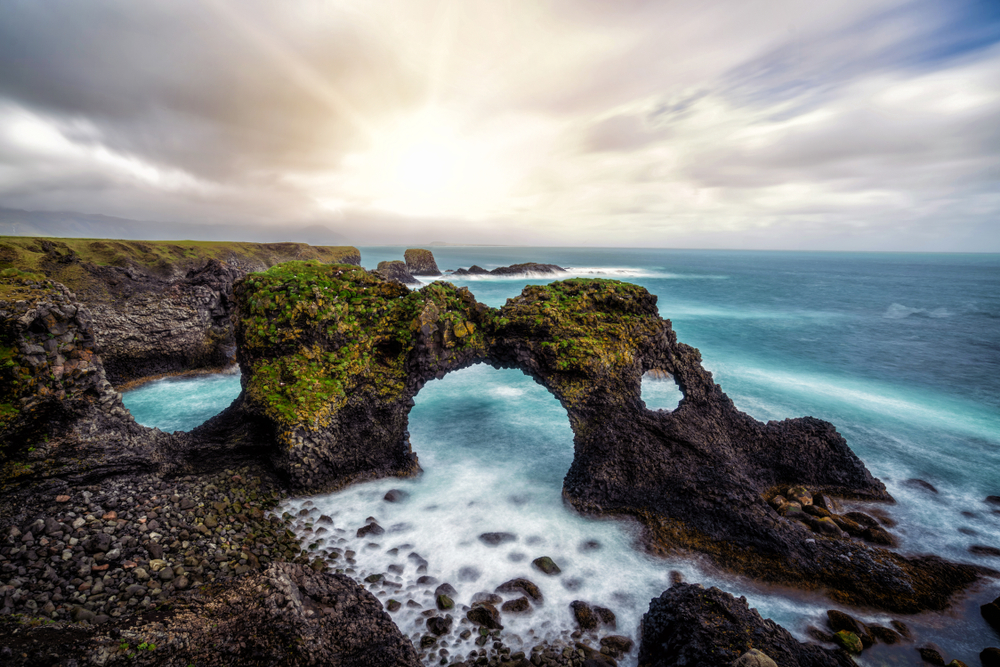
Stop 56: Walk Around The Dramatic, Unique Budir Black Church
The Budir Black Church on the Snaefellsnes Peninsula is not a long stop, but it’s a unique stop. Its pitch-black frame makes it stand out from its surroundings, and it seems to draw photographers in like bugs to a lamp.
It’s one of the few black churches in Iceland and seems to have been plucked out of nowhere and placed in the middle of a dramatic natural environment. With Iceland’s frequently stormy weather, photographs of the church end up looking particularly moody.
The church was built in 1703 but has undergone deconstructions and reconstructions since then. It stands relatively by itself as part of a small village with a graveyard and tall flowing grass surrounding it. As dark and dreary as that sounds, its isolated location is actually part of its appeal.
In addition, its proximity to the beach and the vast Atlantic Ocean, with mountains and glaciers framing the shot in the background, make it a particularly enjoyable location. It’s often a site for weddings as well.
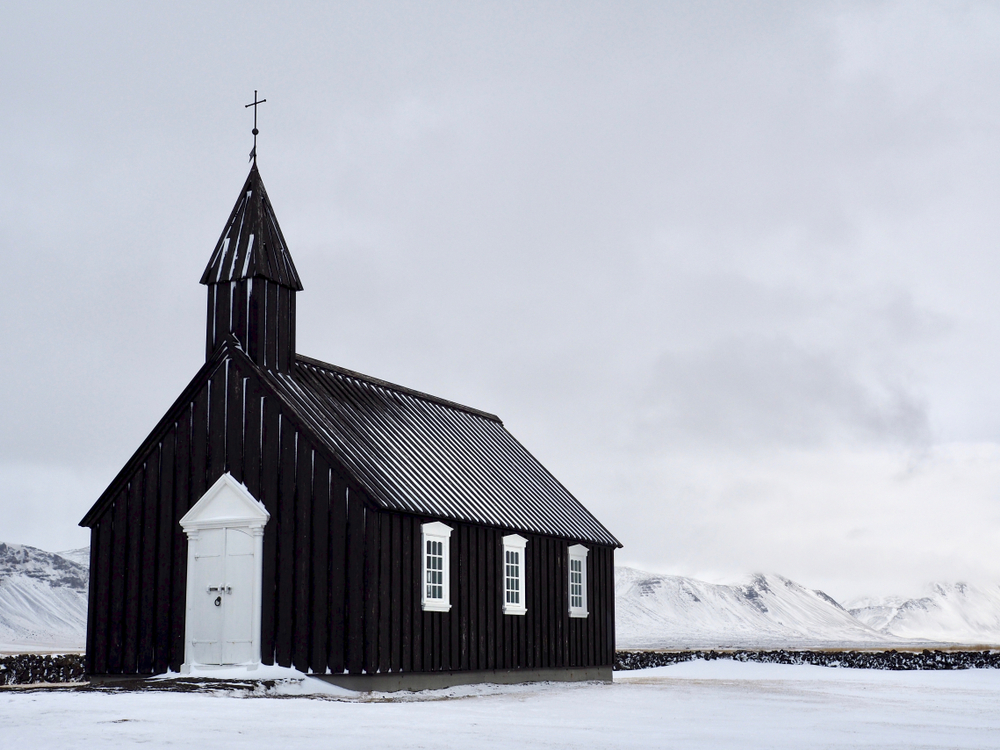
Stop 57: Hike The Steep Climb To Iceland’s 2nd Highest Waterfall, Glymur
The 650-foot Glymur Waterfall is Iceland’s second-highest waterfall, and what a beauty it is. Reaching the waterfall is moderately difficult and involves grabbing on to chains for assistance in steep sections, and potential river crossings.
The first river crossing occurs fairly early on in the hike. In the summer a log is provided for you to walk across with a rope to steady your balance. In the winter though, the log is taken away and you have to wade through the water.
The other river crossing happens halfway through the hike where you can choose to either hike back down the way you came, or continue hiking back up behind the waterfall and cross the river before hiking back down using the trail on the opposite side of the waterfall. If you’re up for the upper river crossing (be aware that the water is very cold and the river bottom is rocky), we recommend hiking back down on the other side for a different view and perspective of the waterfall.
The full hike will likely take you a few hours taking you past beautiful views for much of the way. And of course the ultimate payoff is Glymur itself falling majestically in the middle of moss covered canyon walls.

Stop 58: Enjoy An Up Close Experience With Boiling Hot Springs At Deildartunguhver
The Deildartunguhver Hot Springs are another example of Iceland’s remarkable natural geothermal water. The area is relatively small, and it’ll likely be a quick stop for you, but watching the water boiling straight from the ground is a fascinating sight. These hot springs are certainly not for bathing in or even getting close to as the water temperature hovers just over 200°C.
A fence separates you from the powerfully bubbling water ensuring that visitors keep a safe distance, but even with the minimal separation, you’ll find yourself enveloped in the steam from the hot spring. Deildartunguhver provides the water for the towns of Akranes and Borganes among other smaller settlements within a 65-kilometer radius. And though the water is untouchable at the hot springs themselves, if you’re particularly anxious to bathe in its waters you might venture over to the Krauma Geothermal Baths where this very same water is cooled to a bathing temperature and enjoyed by visitors a plenty!
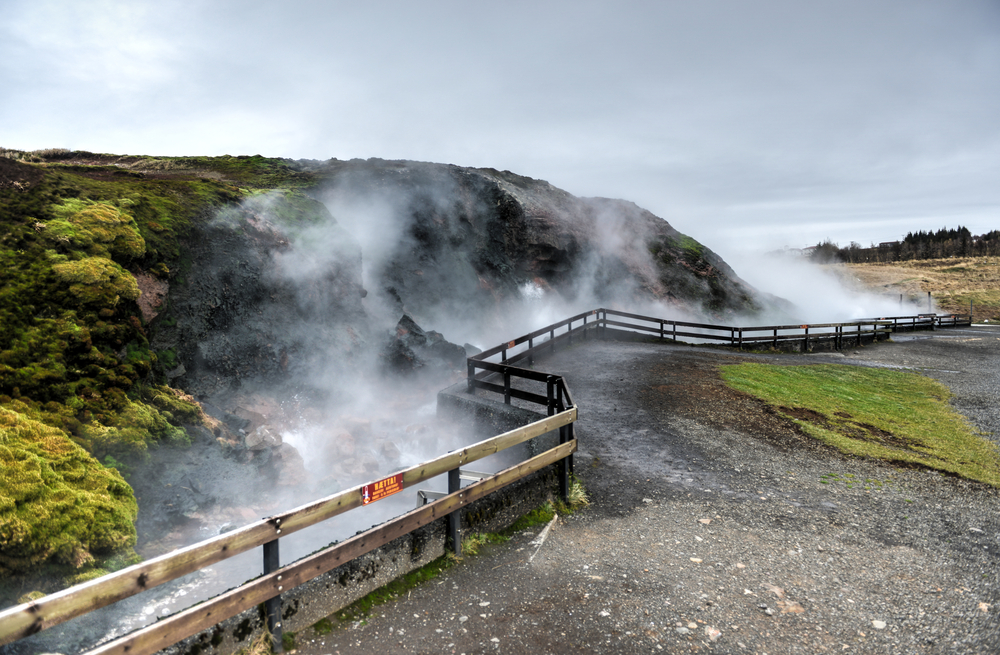
Stop 59: Marvel At The Last Of Your Iceland Ring Road Waterfalls At Hraunfossar and Barnafoss
At this point in your Iceland Ring Road Itinerary, you’re likely thinking you’ve seen just about every possible variation of a waterfall in existence. Well, think again. Hraunfossar (Lava falls) is remarkably unique and incredibly beautiful.
When you arrive you’ll find a decent-sized parking lot, bathrooms (there’s a small fee), and a café with delicious food. A pathway from the parking lot will lead you to a handful of observation decks for viewing Hraunfossar from multiple angles as well as its neighbor waterfall Barnafoss.
We suggest visiting Barnafoss first. It’s a wonderful little fall bursting out of a channel and small archway, but it is certainly secondary to the more impressive Hraunfossar.
Unlike many of Iceland’s waterfalls, Hraunfossar is incredibly wide, spanning just over half a mile. The falls cascade in lacy, magical sections over an expanse of lava. It’s beautiful from all angles and at different times of year.
In the winter, a thin layer of snow covers the black lava and the water looks wonderfully blue in comparison. Be sure to wear crampons though as the pathway gets icy. In the fall, the plants surrounding the falls turn beautiful shades of orange and red, and in summer the area becomes lush and green.
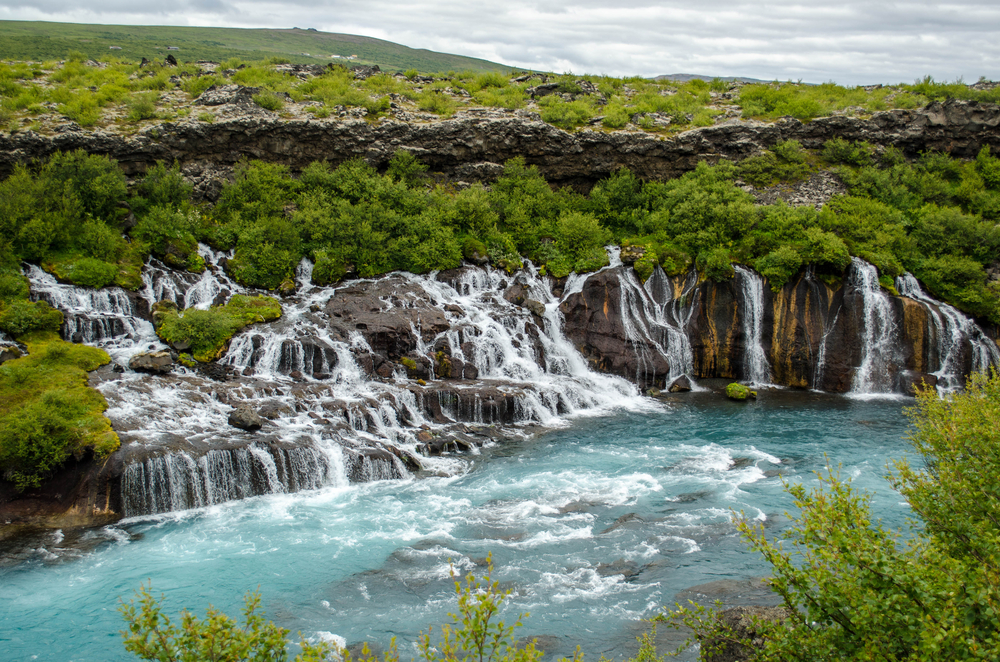
Stop 60: Finish Your Iceland Ring Road Itinerary In The Capital City Of Reykjavik
Reykjavik is Iceland’s colorful capital and its downtown is worth exploring. Laugavegur is the main shopping street filled with shops, café’s, restaurants, galleries, etc. There are also a number of wonderful museums in and around Reykjavik including Perlan’s “Wonders of Iceland” museum, the Reykjavik Maritime Museum, the underground Settlement Exhibition with an excavated longhouse, and the Arbær Open Air Museum with preserved old sod roof Icelandic buildings.
You should also visit the iconic Hallgrimskirkja Church. It’s the tallest building in downtown Reykjavik and has an outside designed to resemble the basalt columns found in nature.
The area in front of the church is dominated by a statue of the explorer Leifur Eiriksson. The real draw of the church is the spectacular view from the tower. Admission to the tower is 1000 ISK per person, which you’ll pay at the church shop before taking an elevator to the top.
Another stop you’ll want to make is to the Harpa Concert Hall, the beautiful concert venue downtown with 714 honeycomb-like glass panels that light up at night. Like Hallgrimskirkja, the design was meant to resemble basalt columns. It stands today as an architectural beauty that is home to festivals, concerts of all music genres, conferences and more.
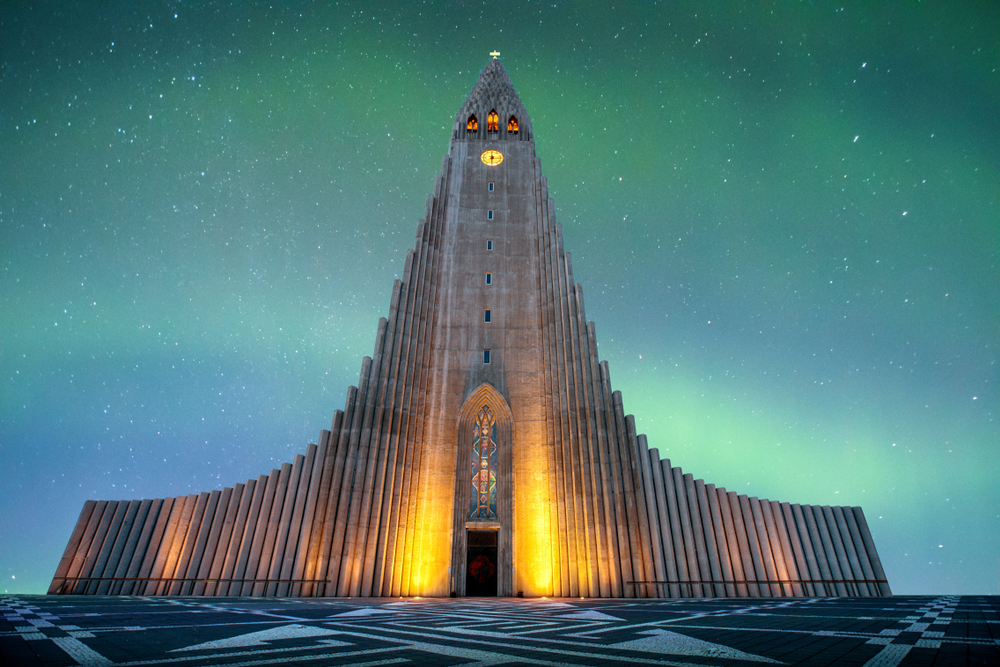
Where To Stay In West Iceland:
Mid-range: Hotel Fransiskus Styykkisholmi. Check rates: Booking.com
Mid-range: Fosshotel Westfjords. Check rates: Booking.com
Luxury: Hotel Borg. Check rates: Booking.com
The Iceland Ring Road is the perfect way to see all the best that this small but spectacular country has to offer. The sheer number of natural wonders to see is remarkable. There’s hardly a dull moment on this trip as you hop from one unique location to the next watching elegantly streaming waterfalls, bathing in natural hot springs and hiking to exceptional viewpoints among so many other things. We’re excited that you’ve chosen to embark on this adventurous journey and hope you’ll find this itinerary helpful. Please let us know in the comments section if you have any questions or just want to share your own travel stories from the Ring Road in Iceland.
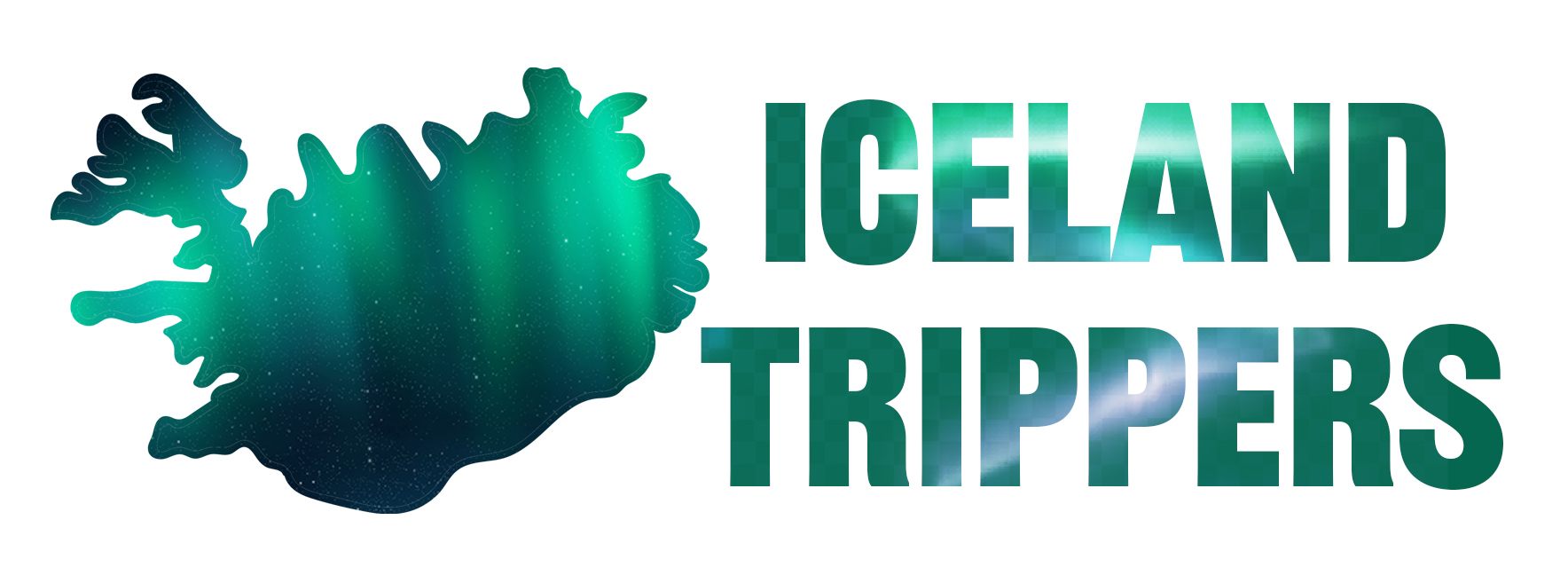
 14 Best Golden Circle Tours In Iceland Worth Your Money
14 Best Golden Circle Tours In Iceland Worth Your Money
Thank you. I found some nice additions to the already long list of places to visit in Iceland.
Awesome information. I’m planning a trip to this island and can’t wait to explore this places. Thank you so much for all you posted here! Will leave comments once I get to visit it. Only one question: should I book different hotels to be closer to almost all of this places to get to visit? Or maybe a hotel in the middle somewhere renting a car. ? Thanks again.. Oscar..
We book different hotels at different stops. So for example, one in Vik for the south coast, one in Hofn for the east and southeast coast etc! And then drive from there 1-2 hours in each direction and that is our home base. You can also do a campervan and take your home with you! Thanks!
When will 20-something bloggers stop posing in silly photos in long skirts? The rest of us just think you’re imbeciles and laugh at you behind you back. Really? When will this insanity end?
When will random men on the internet stop putting down women based on how they look? When will the insanity end?
I agree with Marcos and I’m not a man. What’s with the ridiculous outfits? I see people doing this all over the world but this person is posing in dangerous areas giving others the idea this is how you should dress on the edge of a cliff. Not to mention, these millennials posing like this for Instagram usually hog up the site for the rest of us.
There are 8 photos out of 60+ with skirts, why are you so pressed?
Thanks for this post. Its given me so many ideas. I also love the skirts.
“the rest of us think you’re imbeciles and laugh?”
I am not laughing, nor are the people i’ve forwarded this website to.
You and your attitude are a disgrace. shame on you.
PS. thank you Iceland Trippers, I genuinely feel sorry about this.
Great post. Thank you so much for putting this together. Making my trip planning that much easier. Really appreciate the photos.
Of course!! Enjoy your trip!
Leaving in less than two weeks and this blog has made me SO excited! I have NO idea how we are going to decide what we can fit in in 7 days! Thank you for the incredible information.
Omg yay!!!! That is so exciting!!! In this post we have a suggested 7-day itinerary!!!!! I hope it helps! https://icelandtrippers.com/iceland-itinerary/
stunning photo’s, artistic with a colorful dressed woman !
thanks for all the tips and the effort!
I am obsessed with this itinerary! My husband and I are planning a trip to Iceland this summer. We are going to rent a camper van and plan to spend 6 nights and 7 days driving the ring road. We will end our trip with 3 days at a hotel in downtown Reykjavik. I want to follow this itinerary pretty closely. I know you recommended these 60 stops for a 7 day trip. Would you mind breaking down the stops by day / where to camp or park at night?